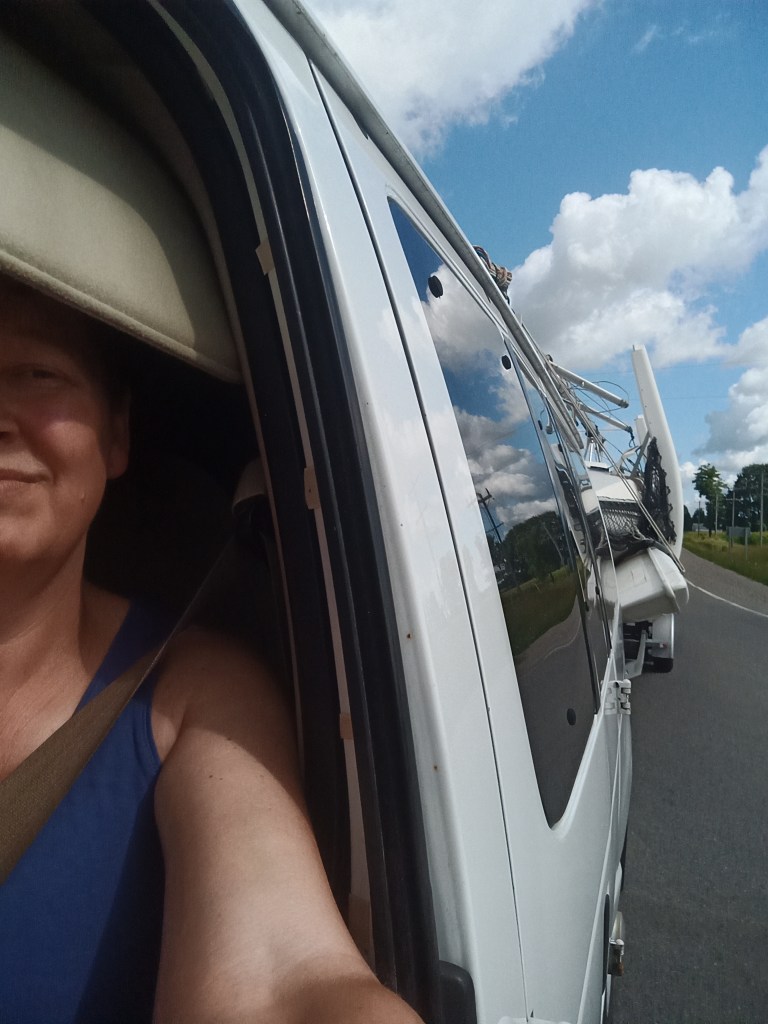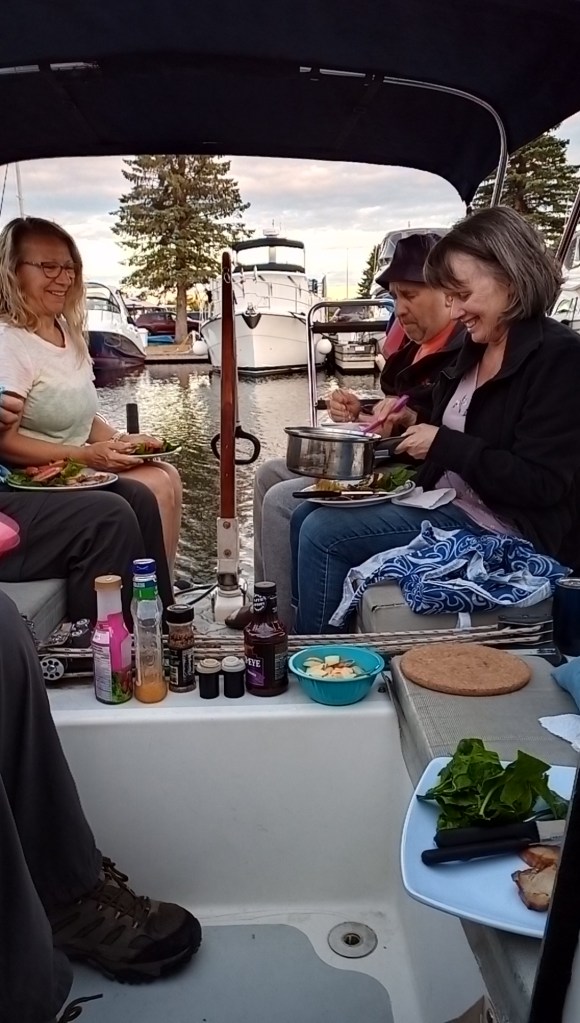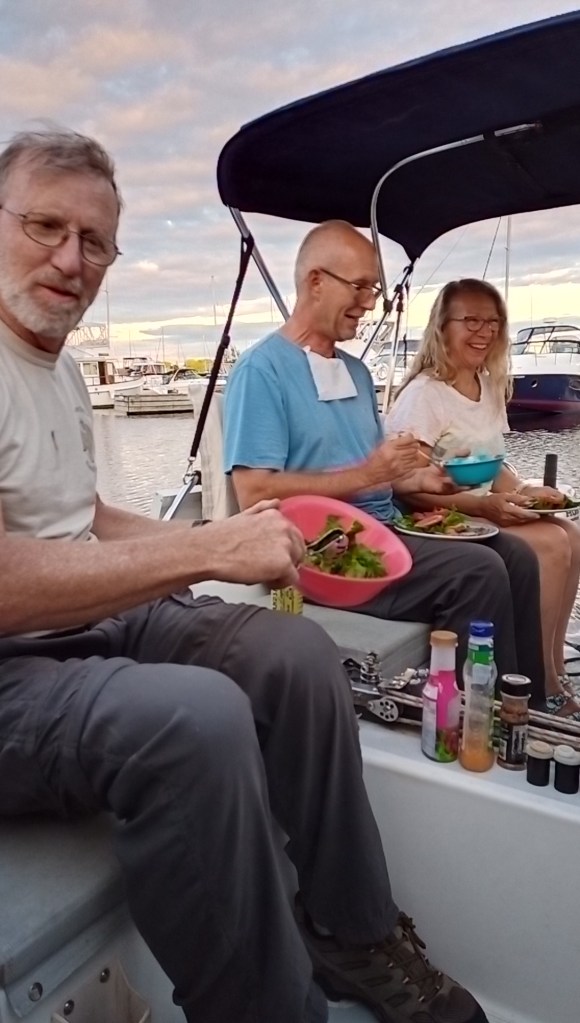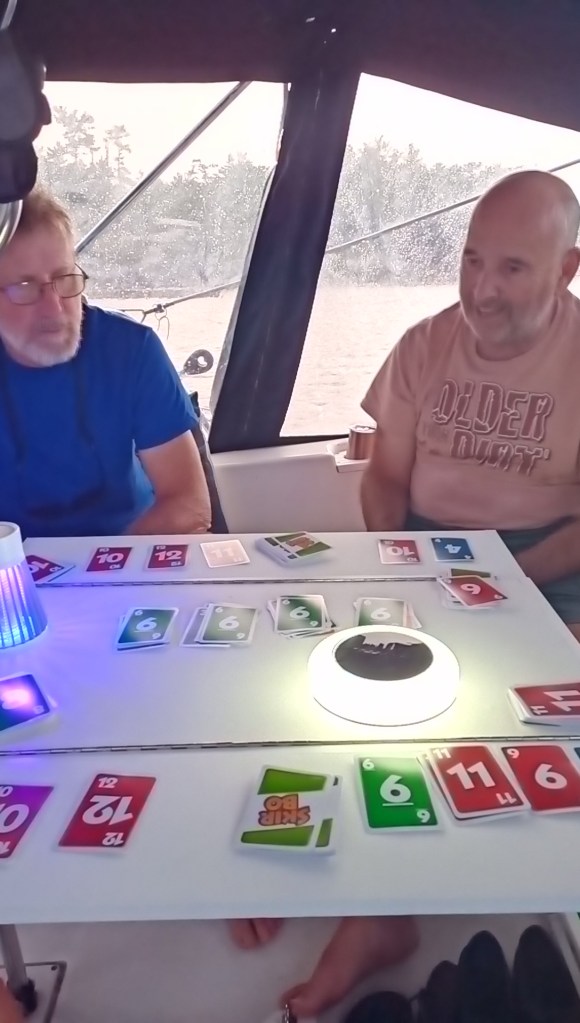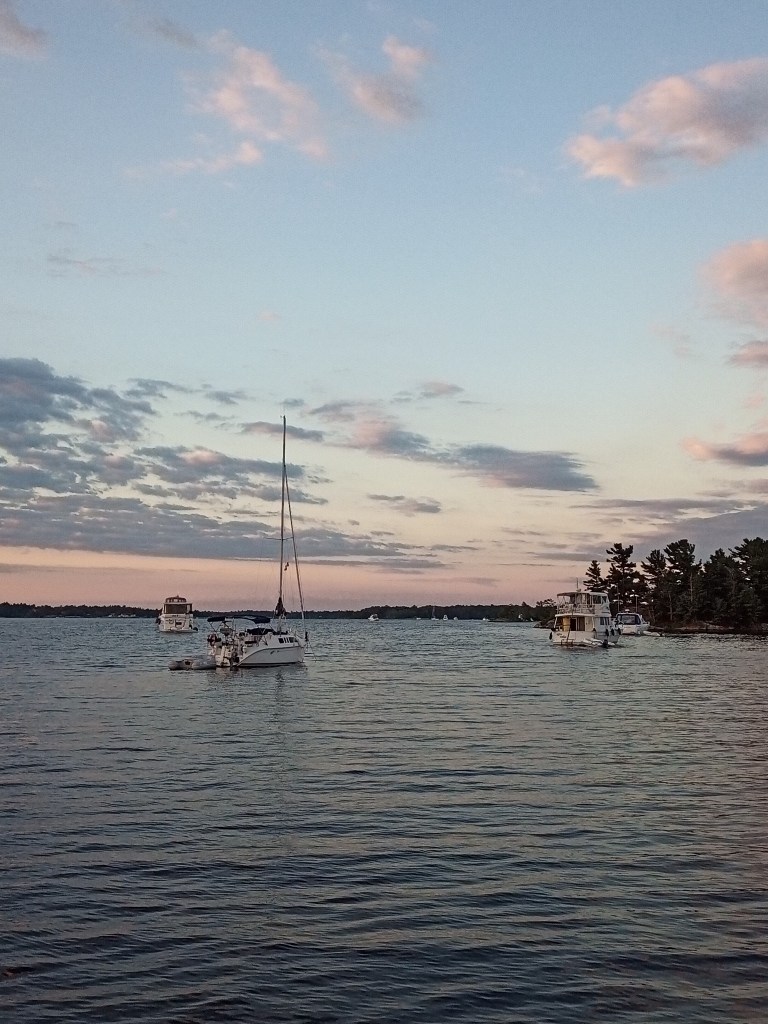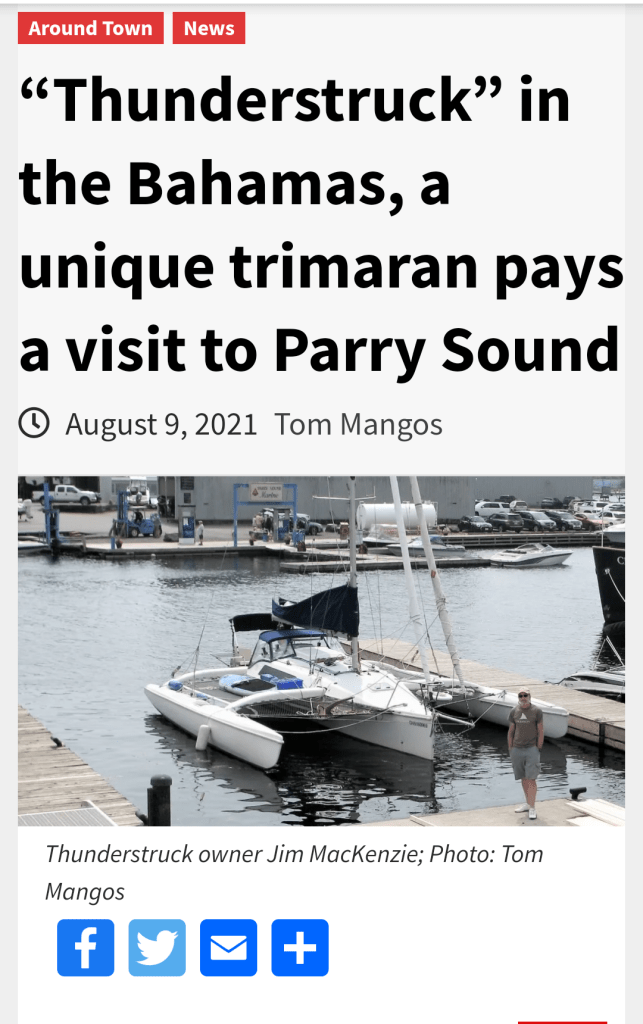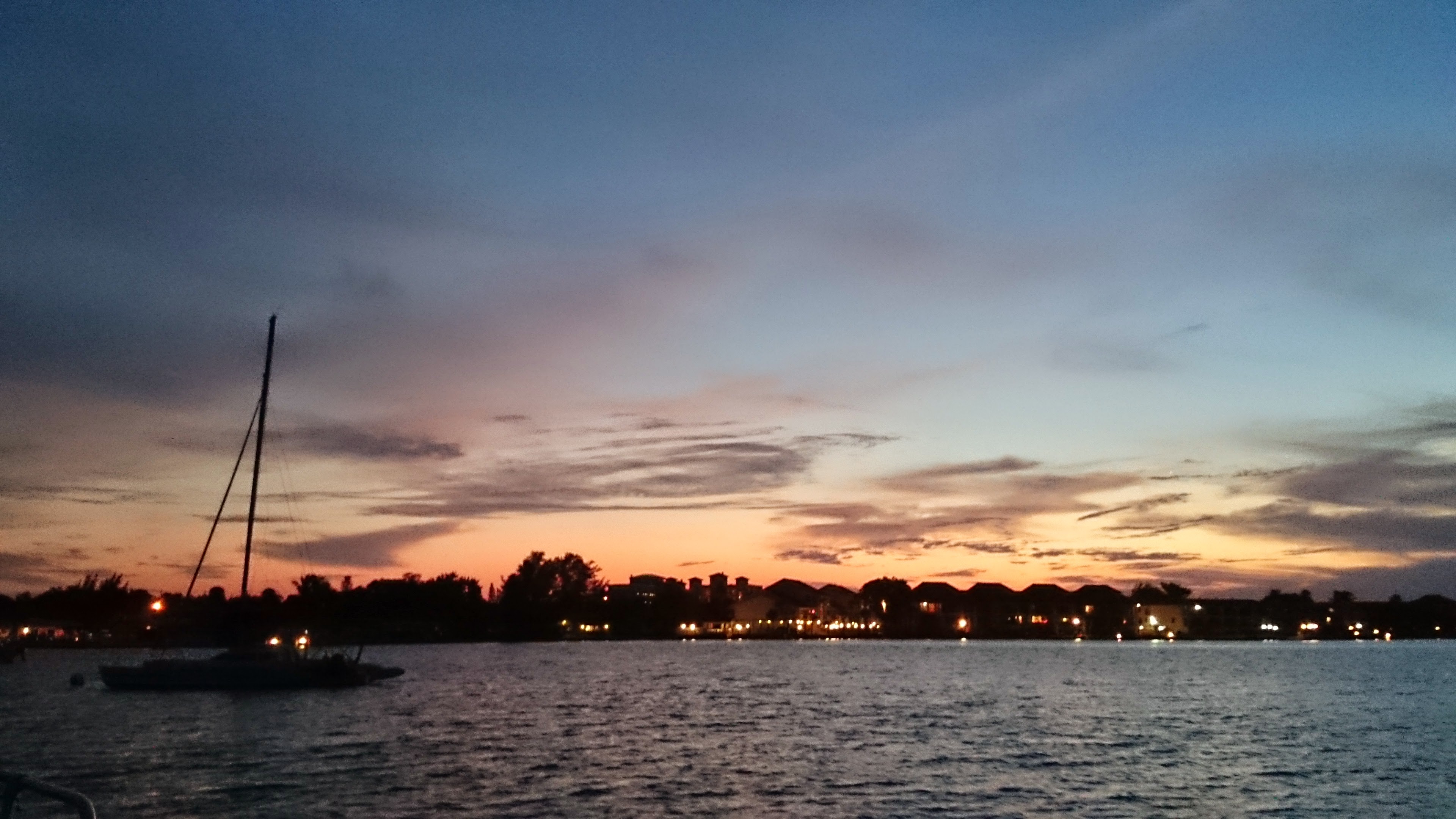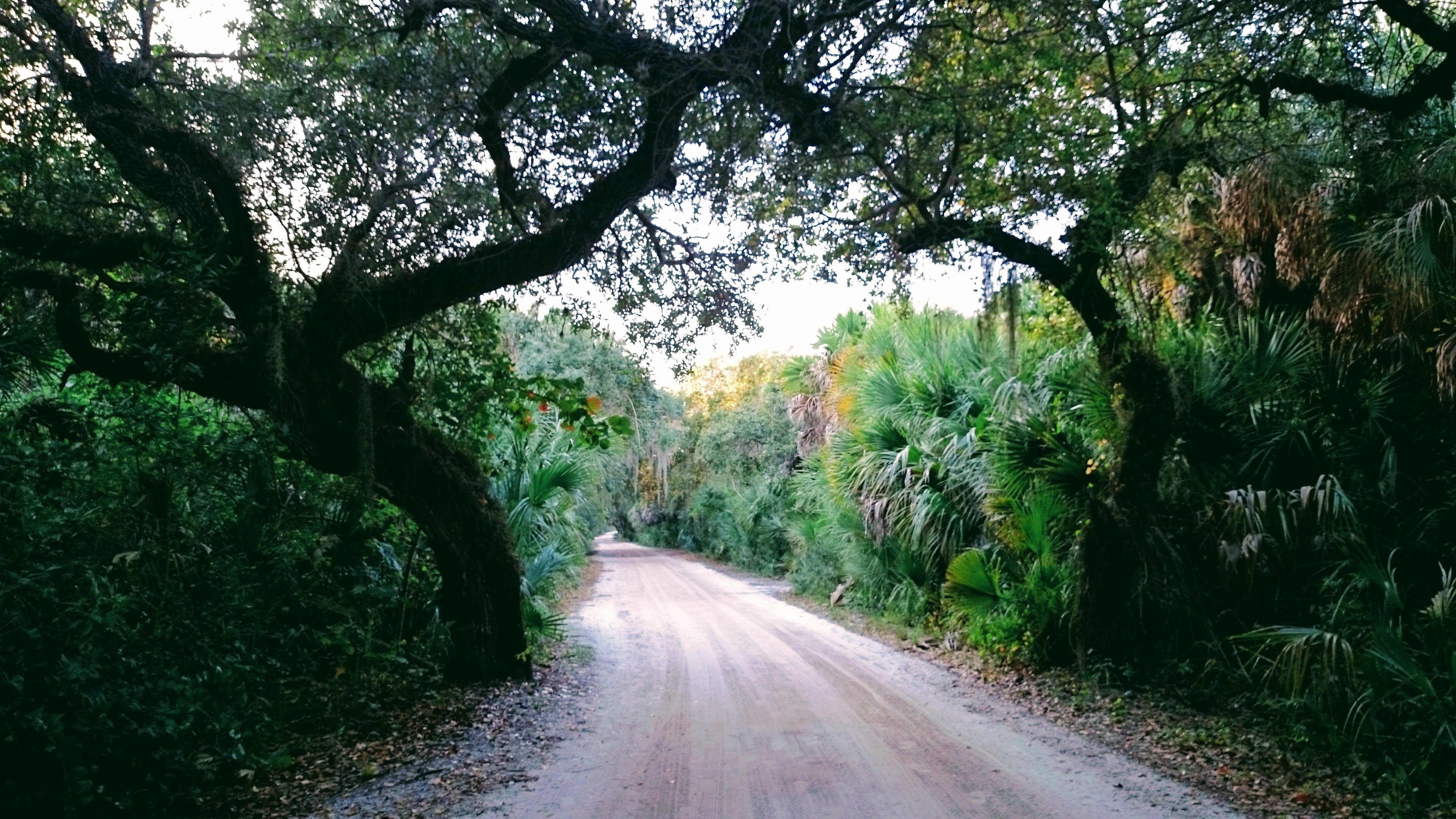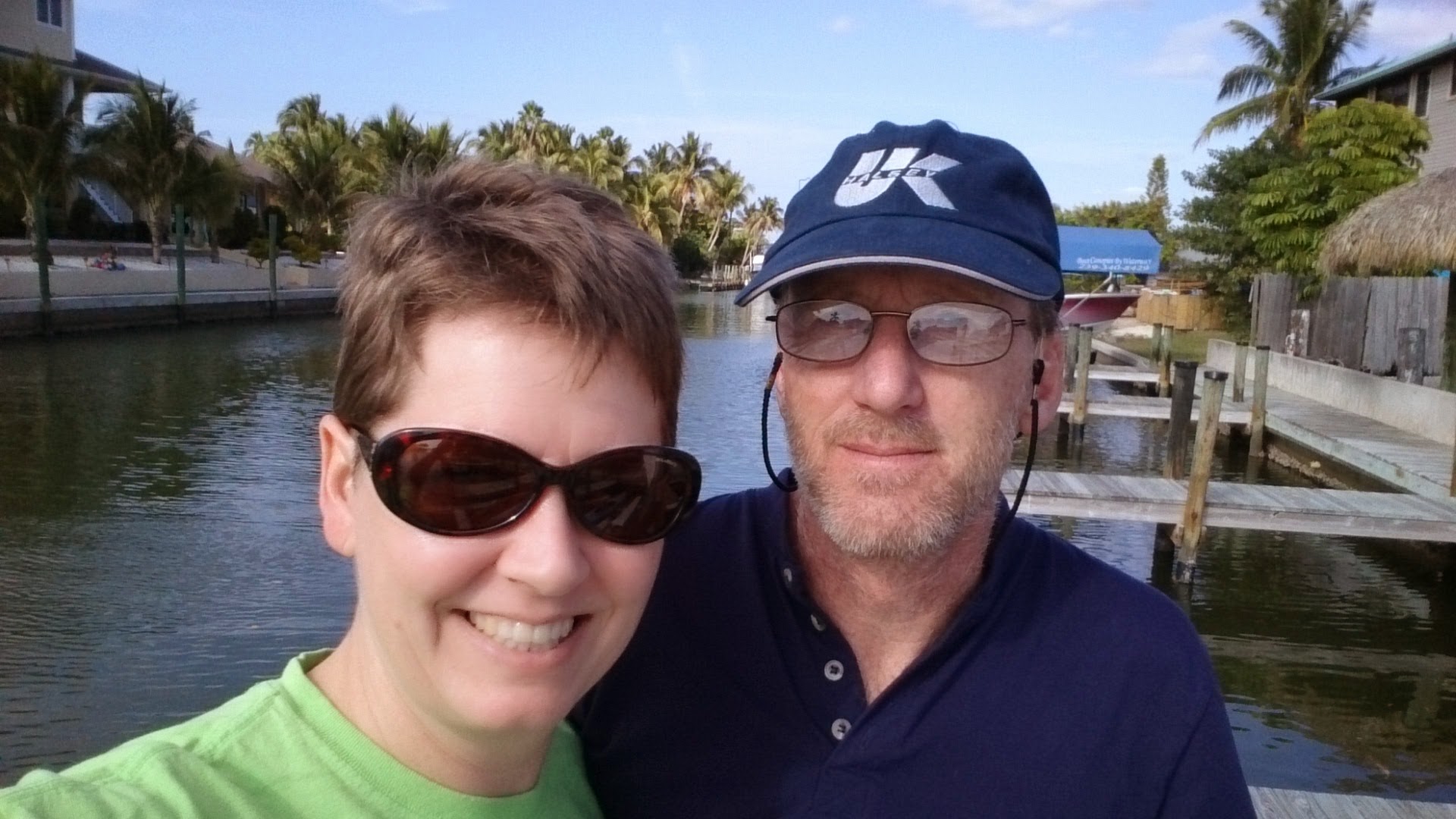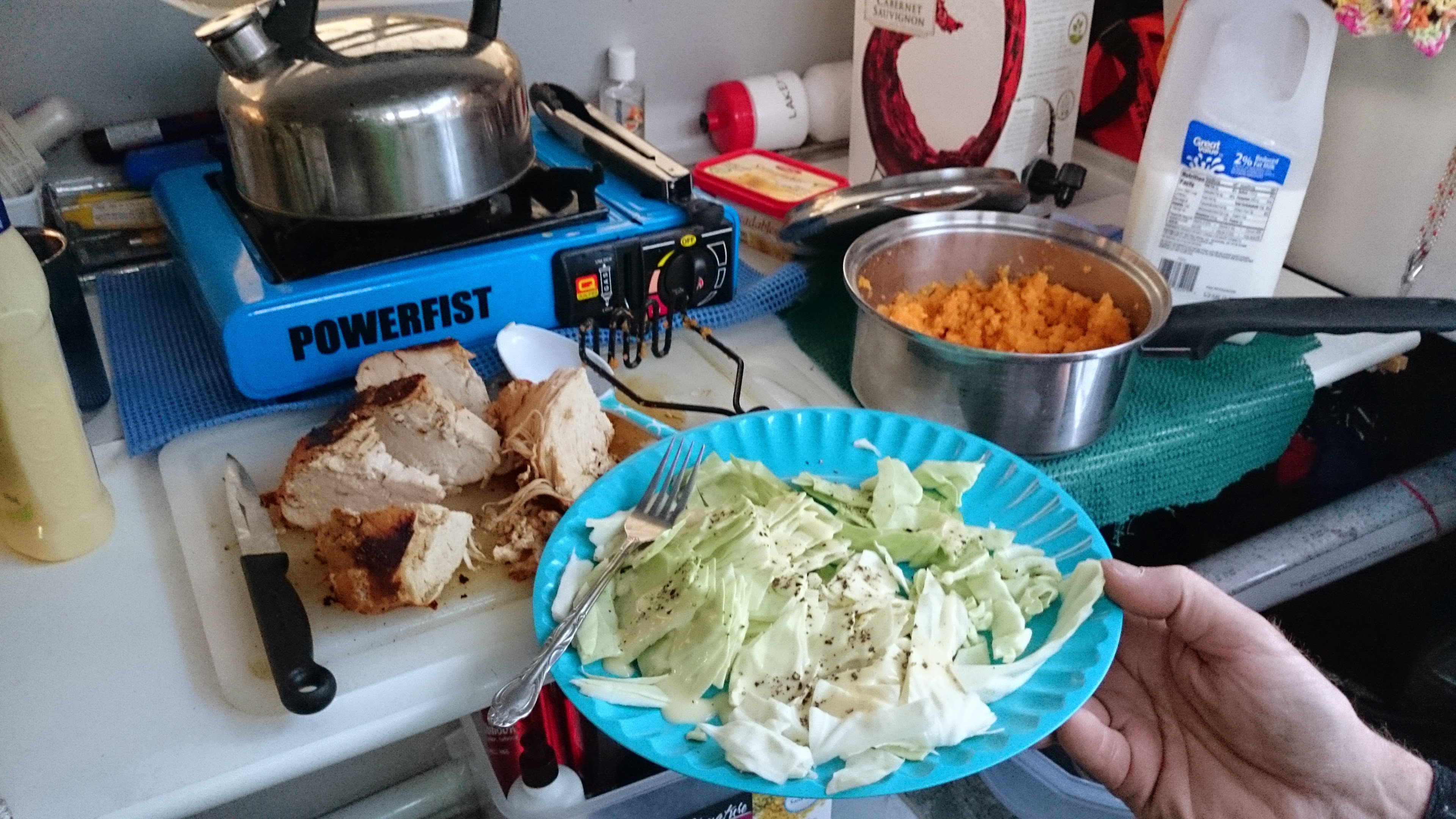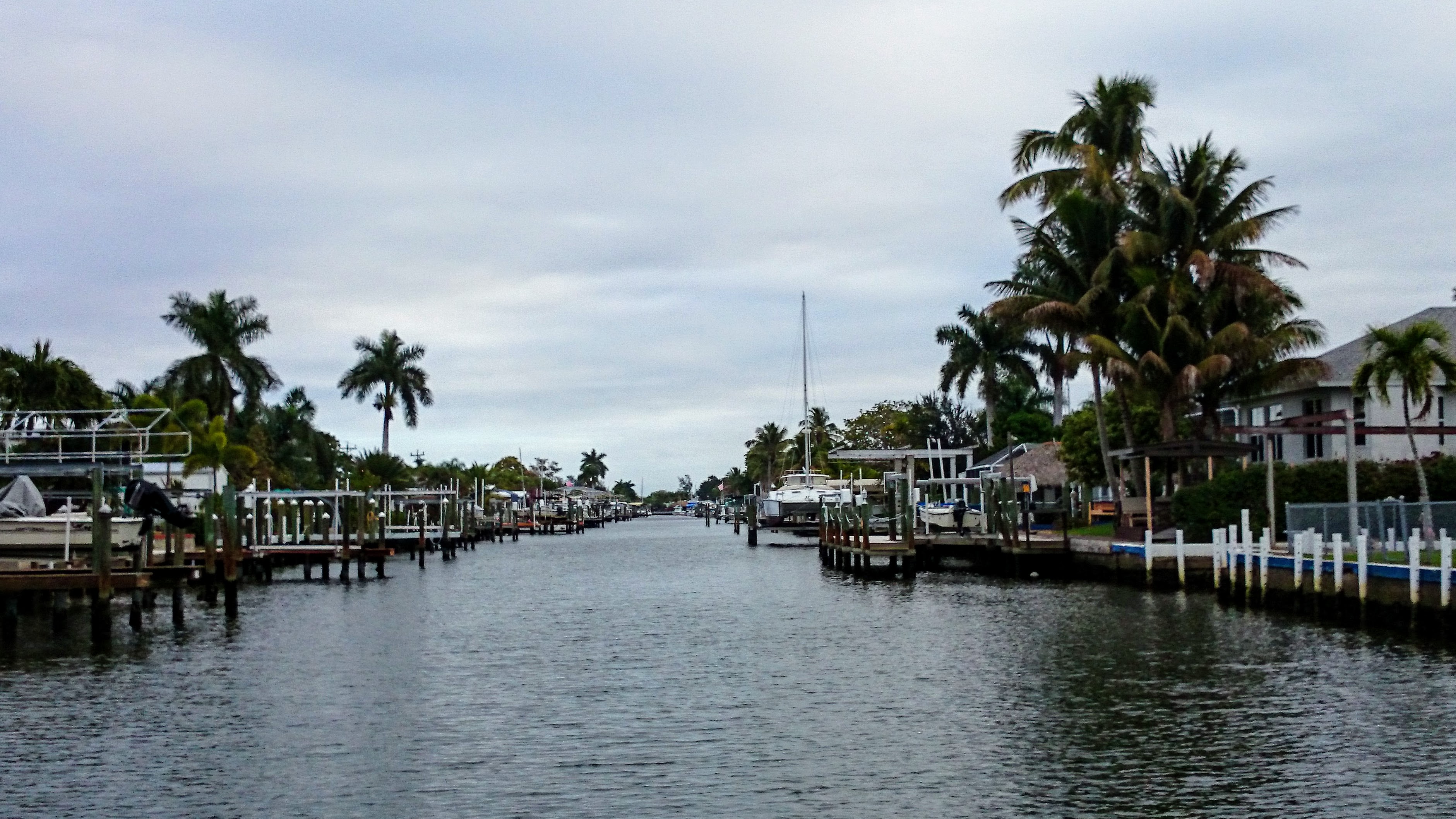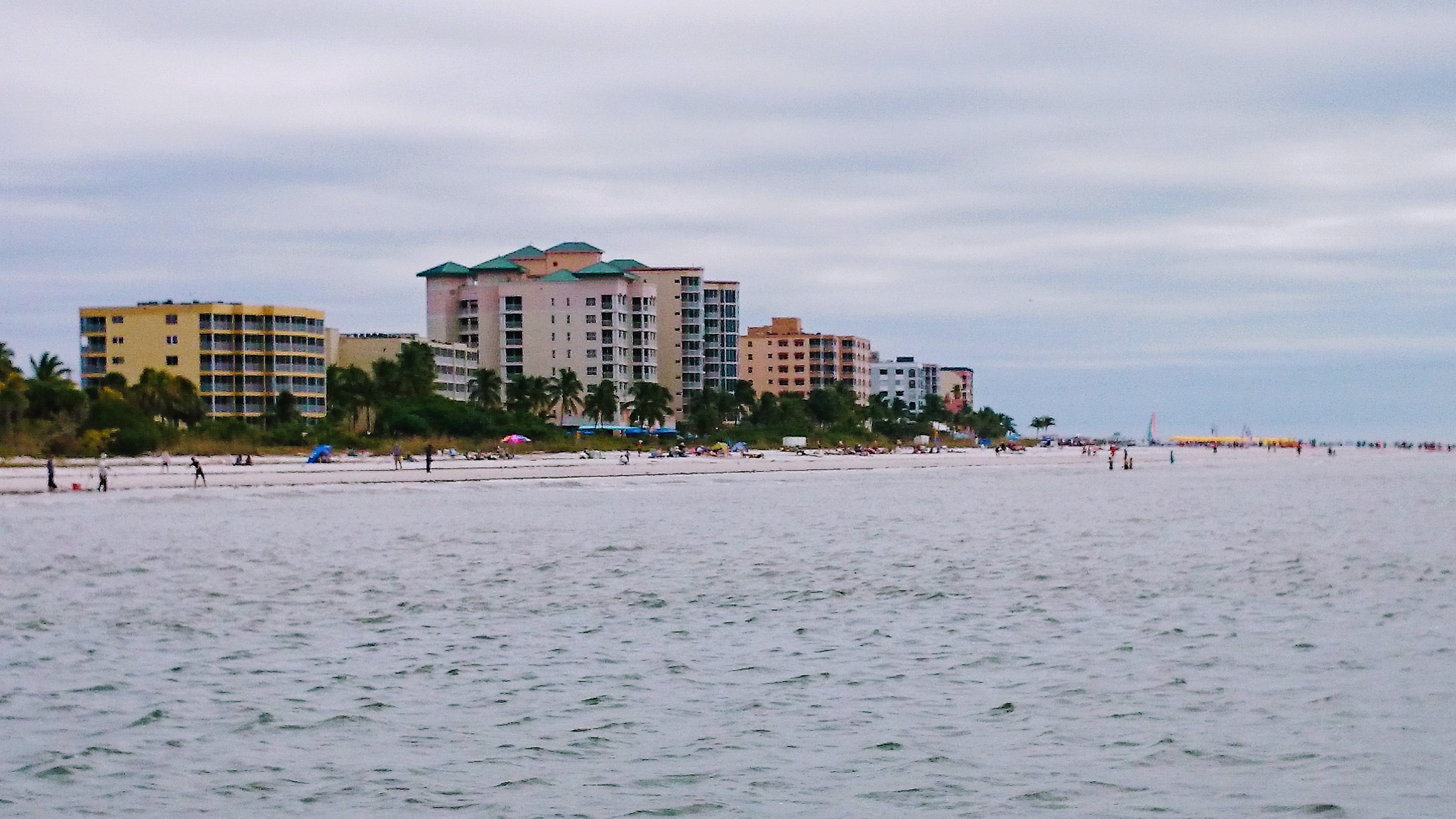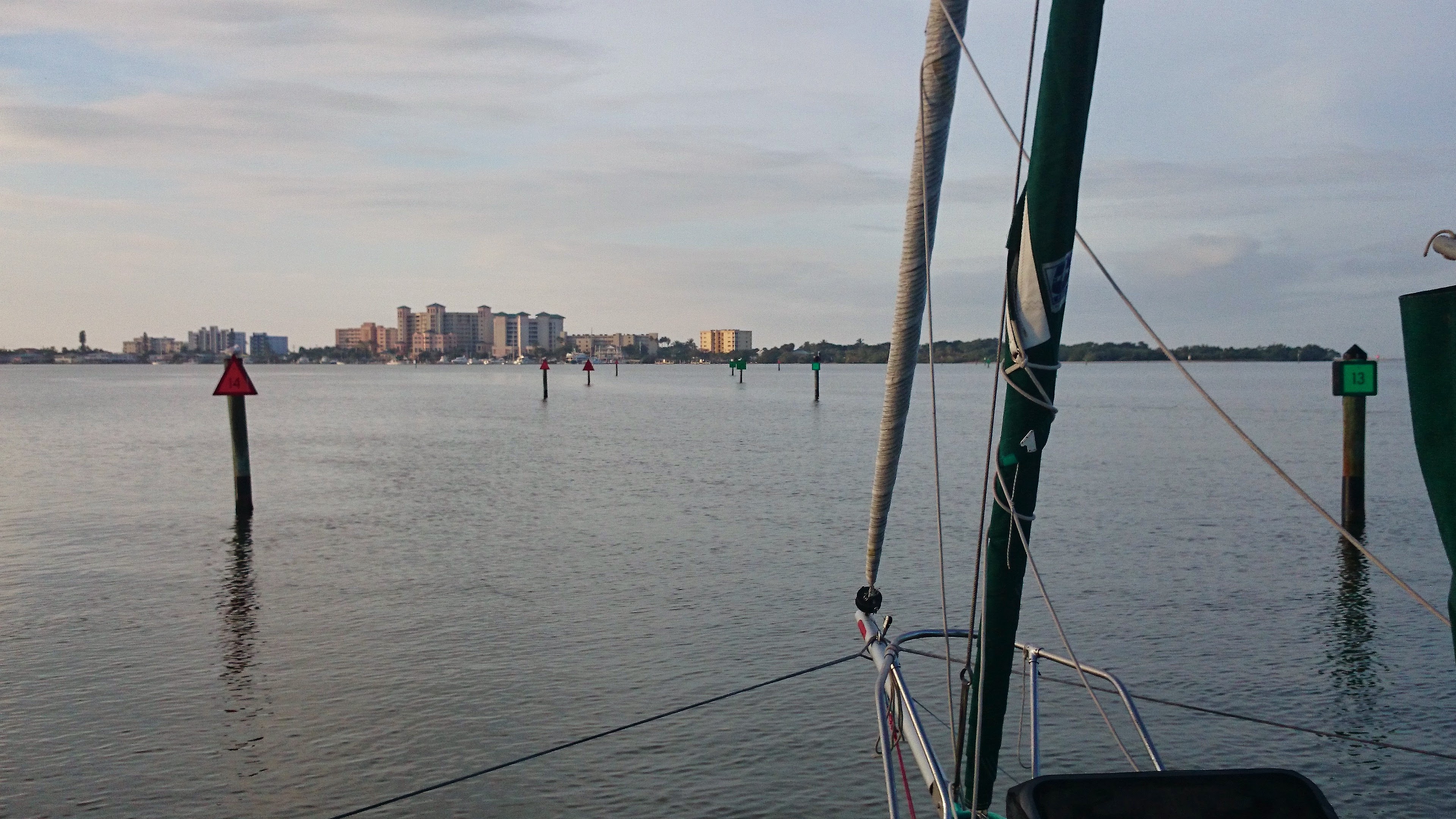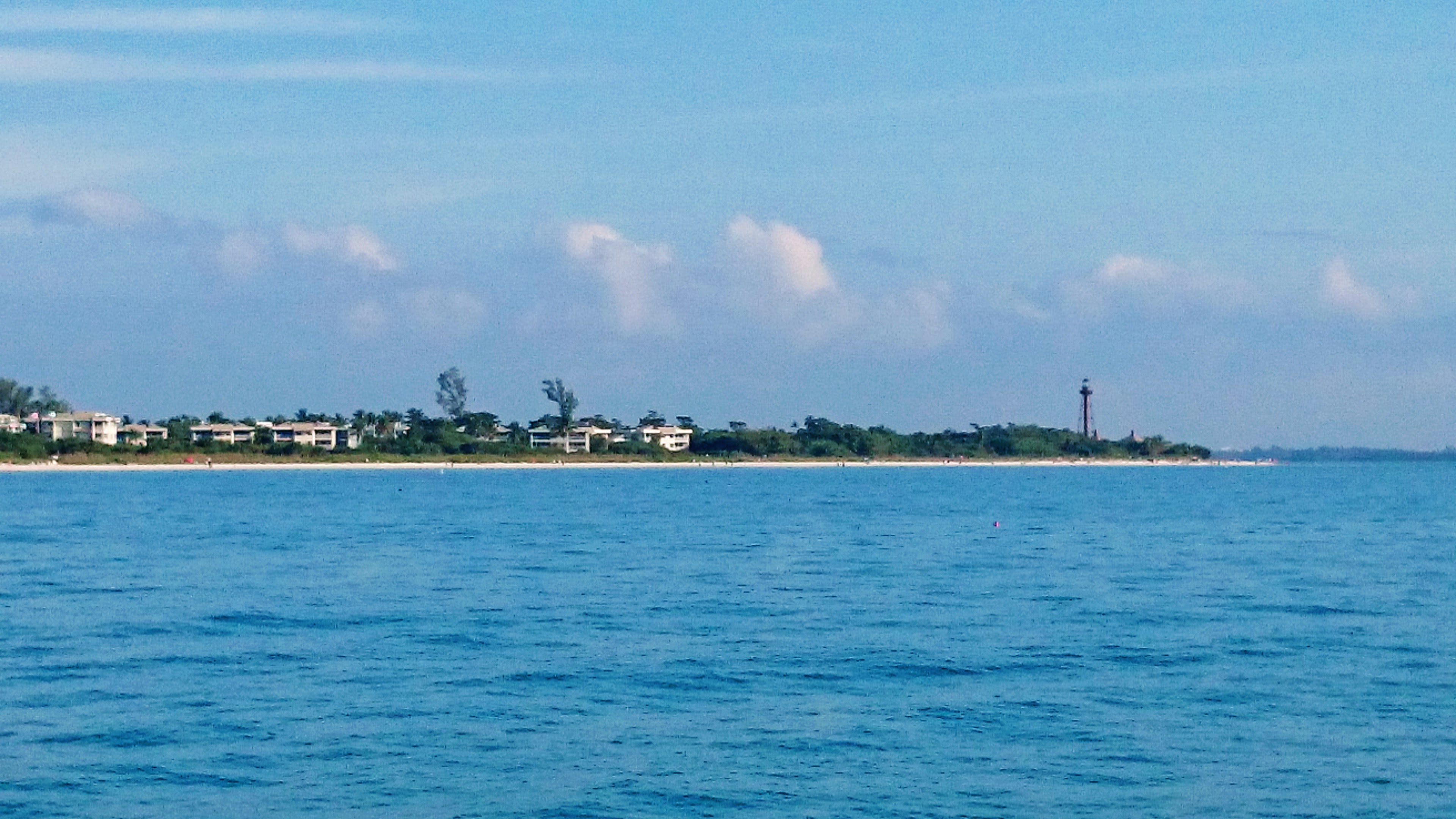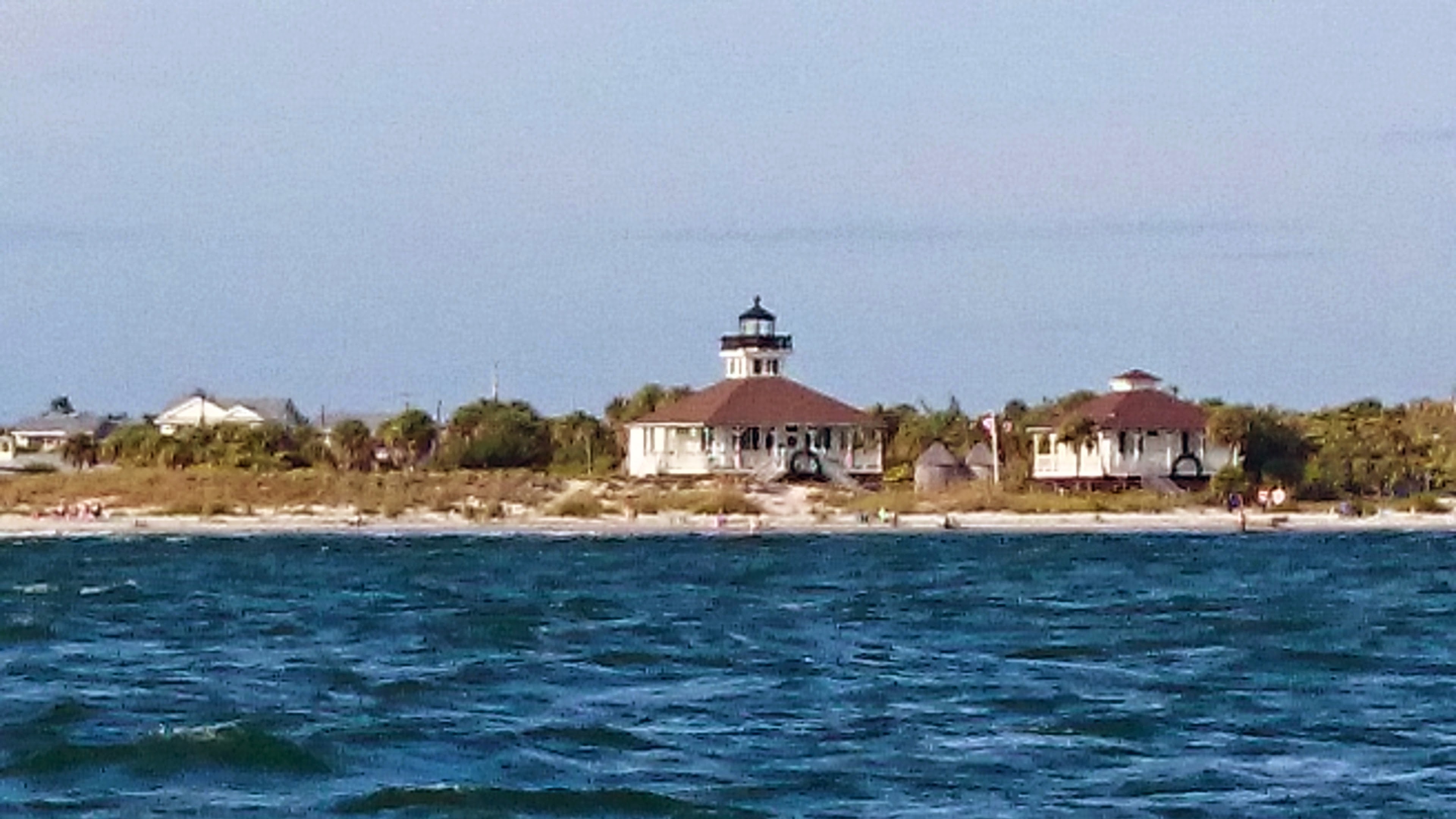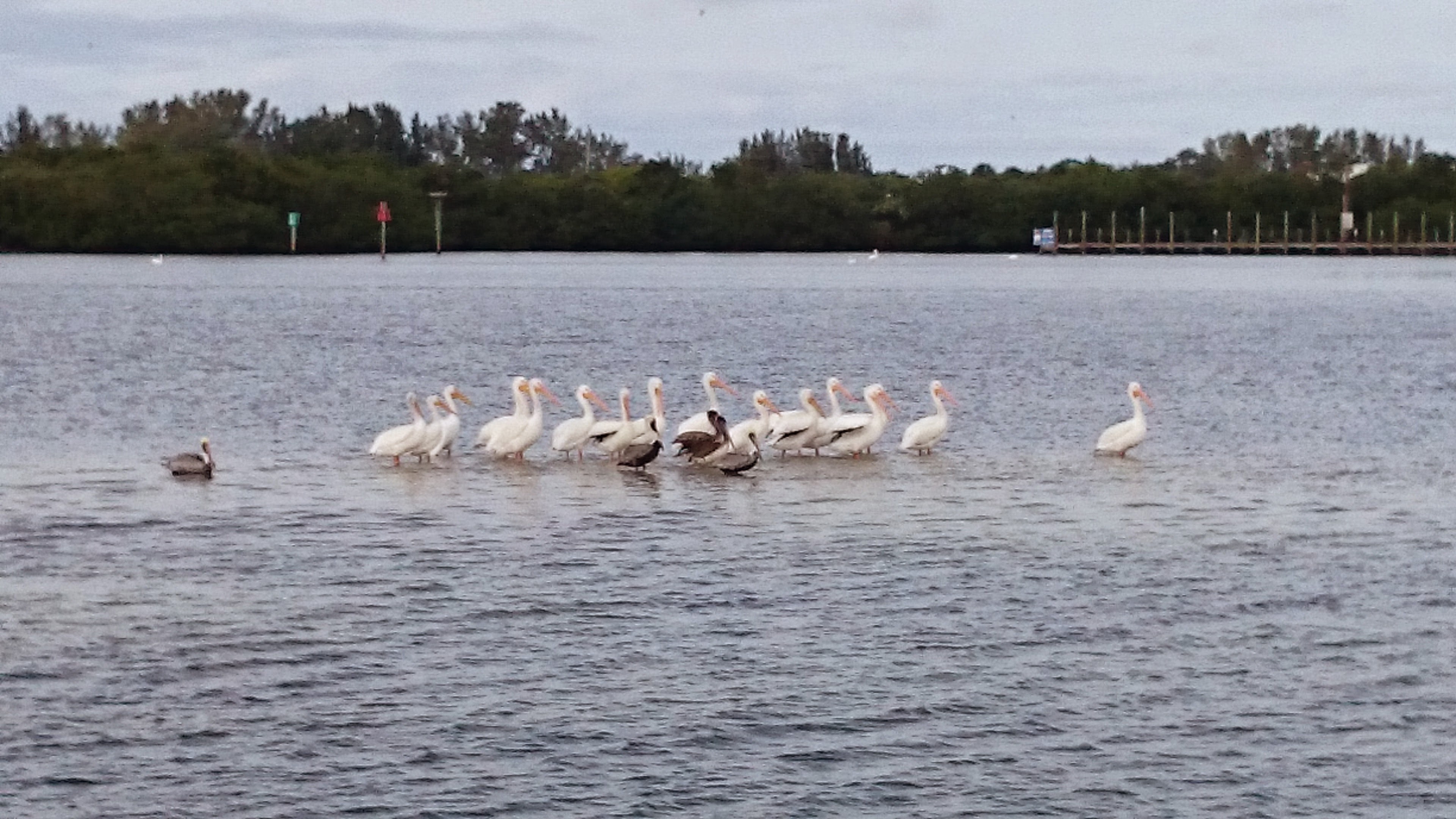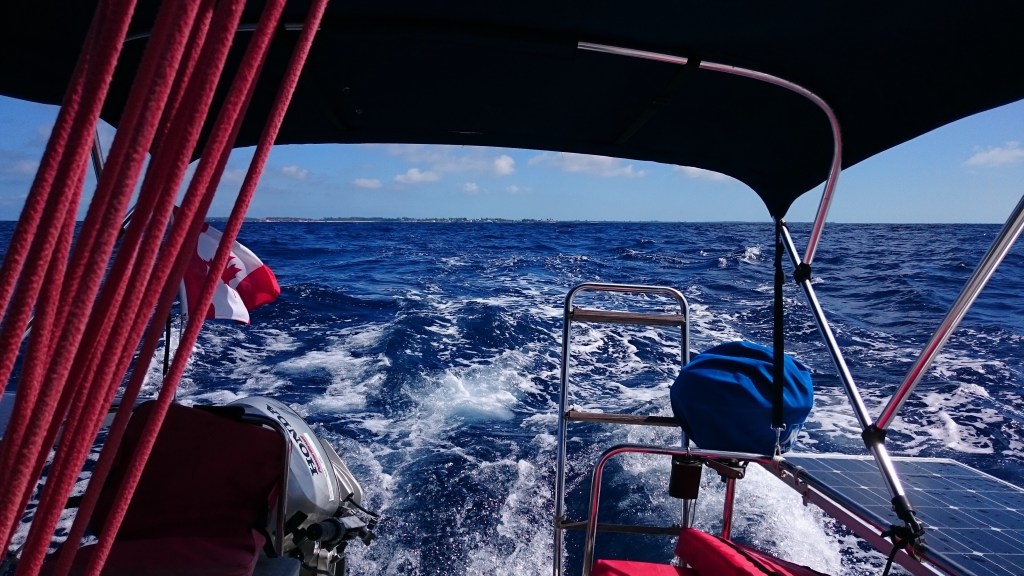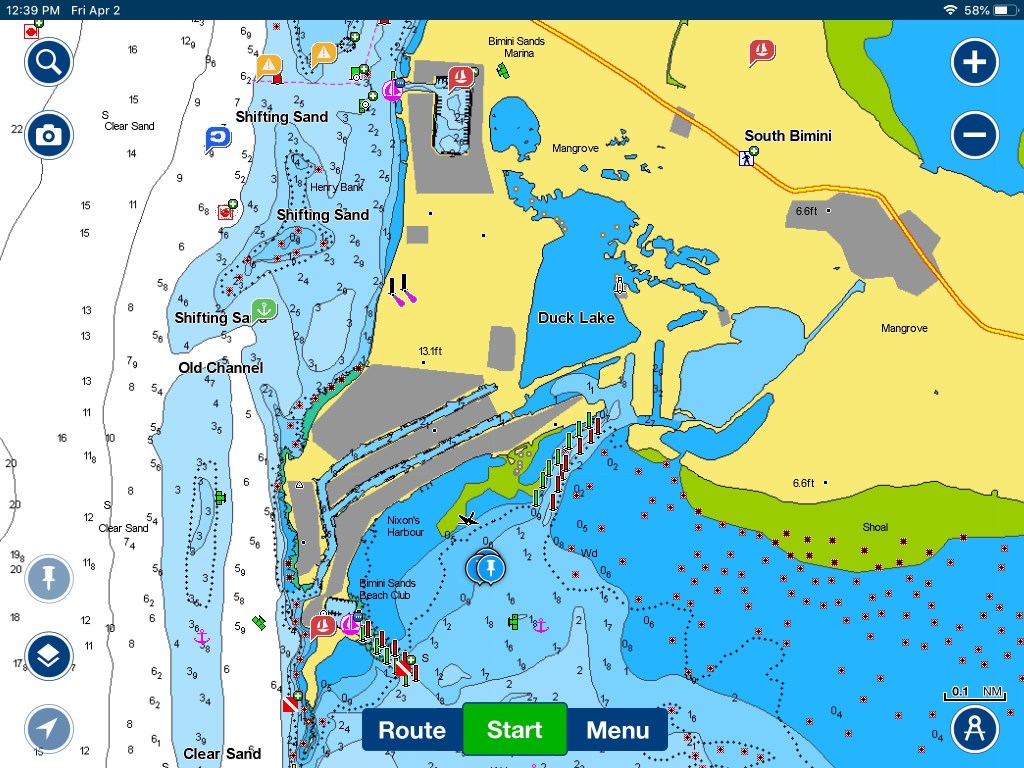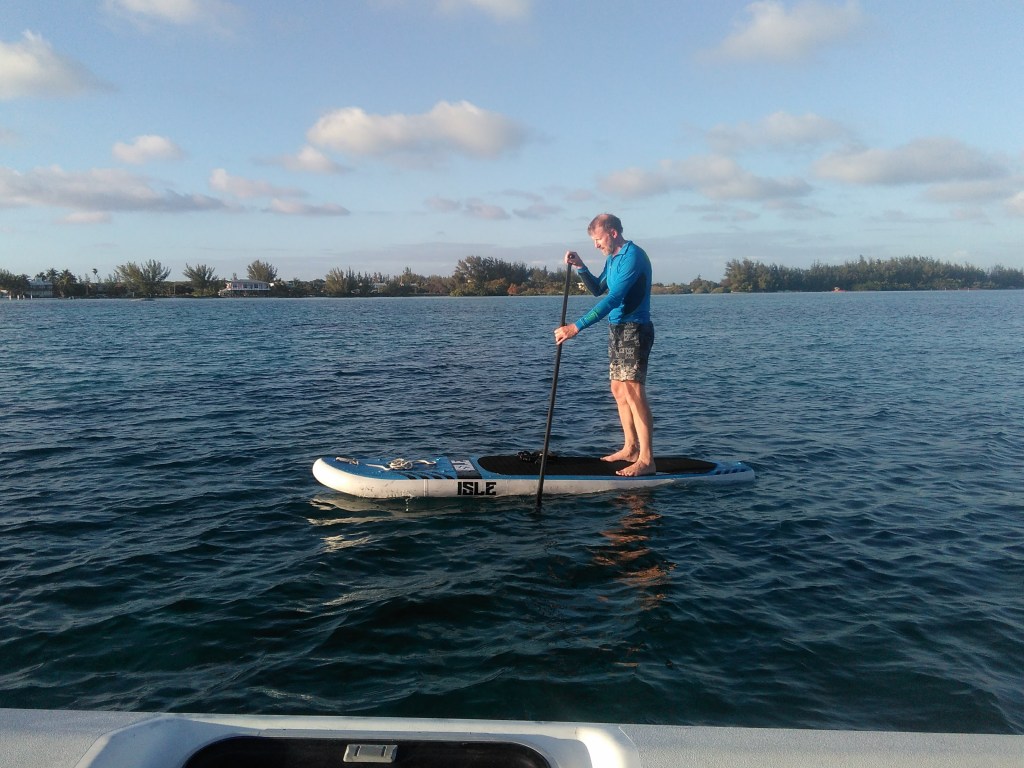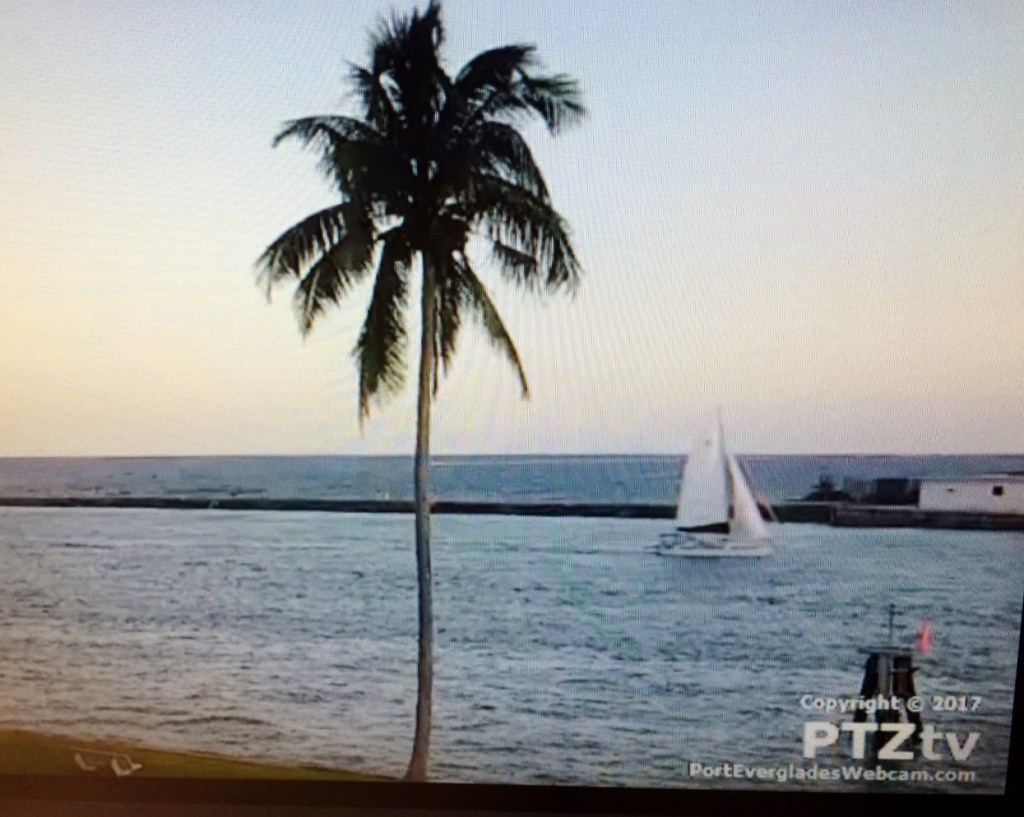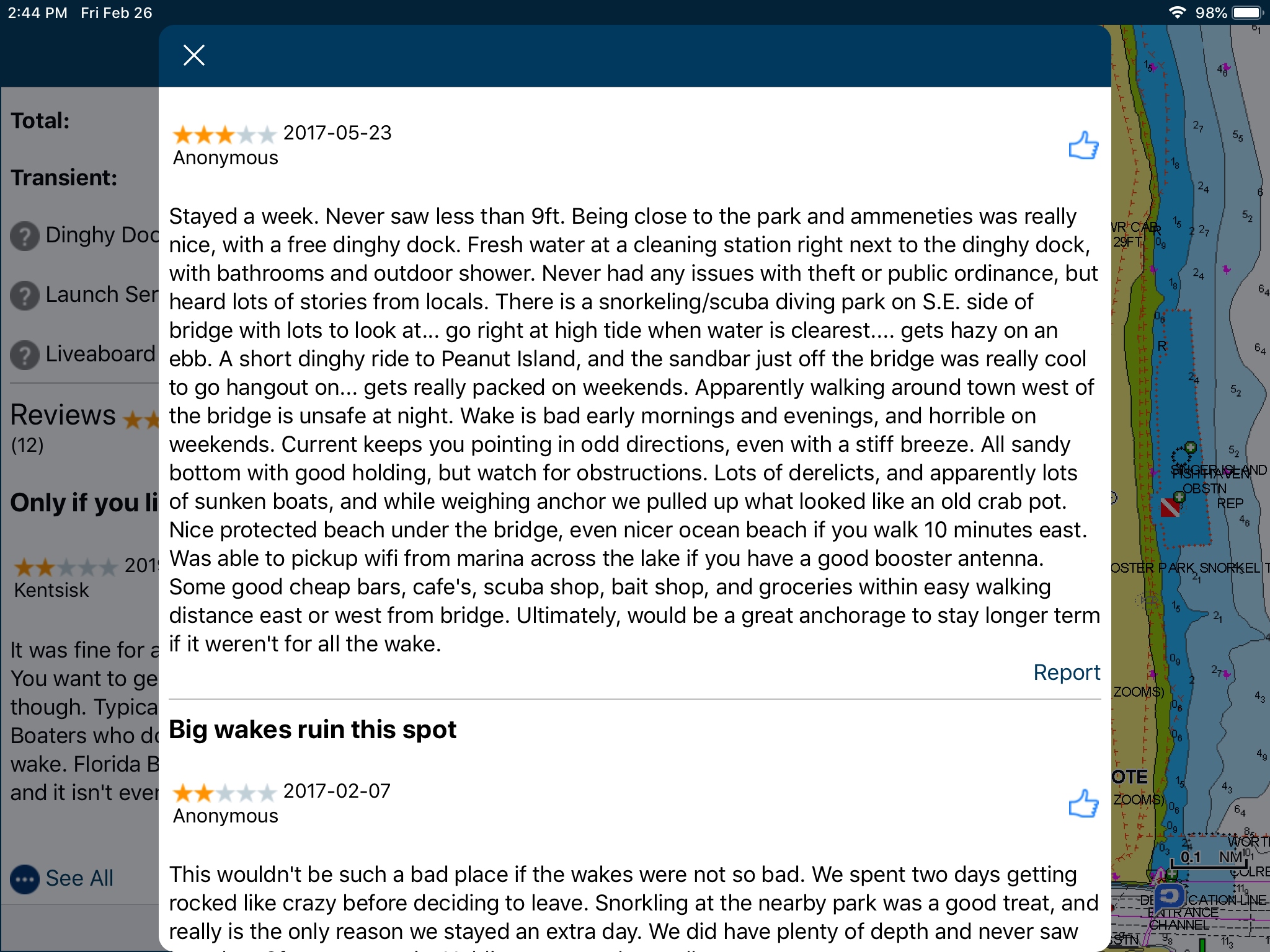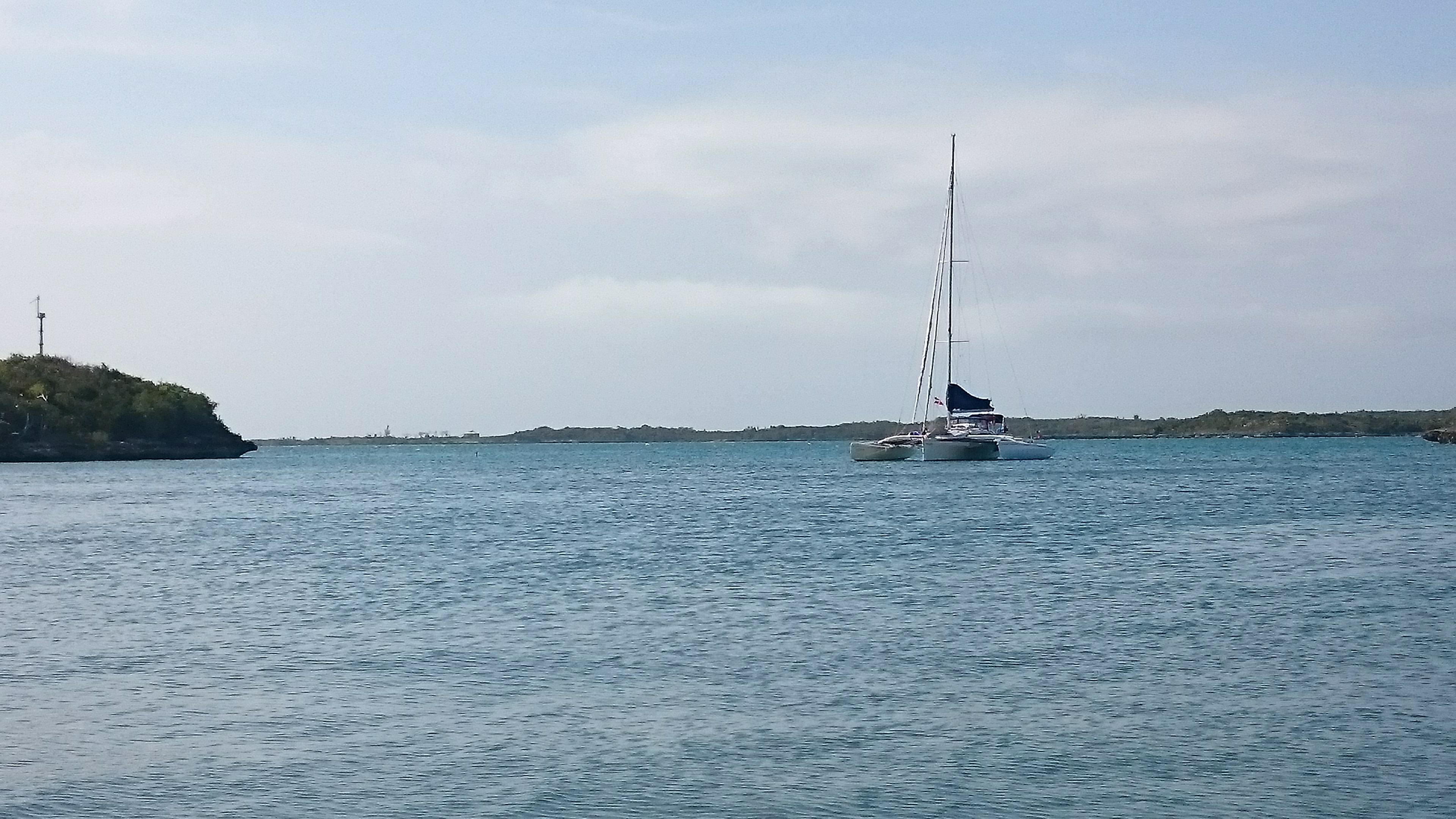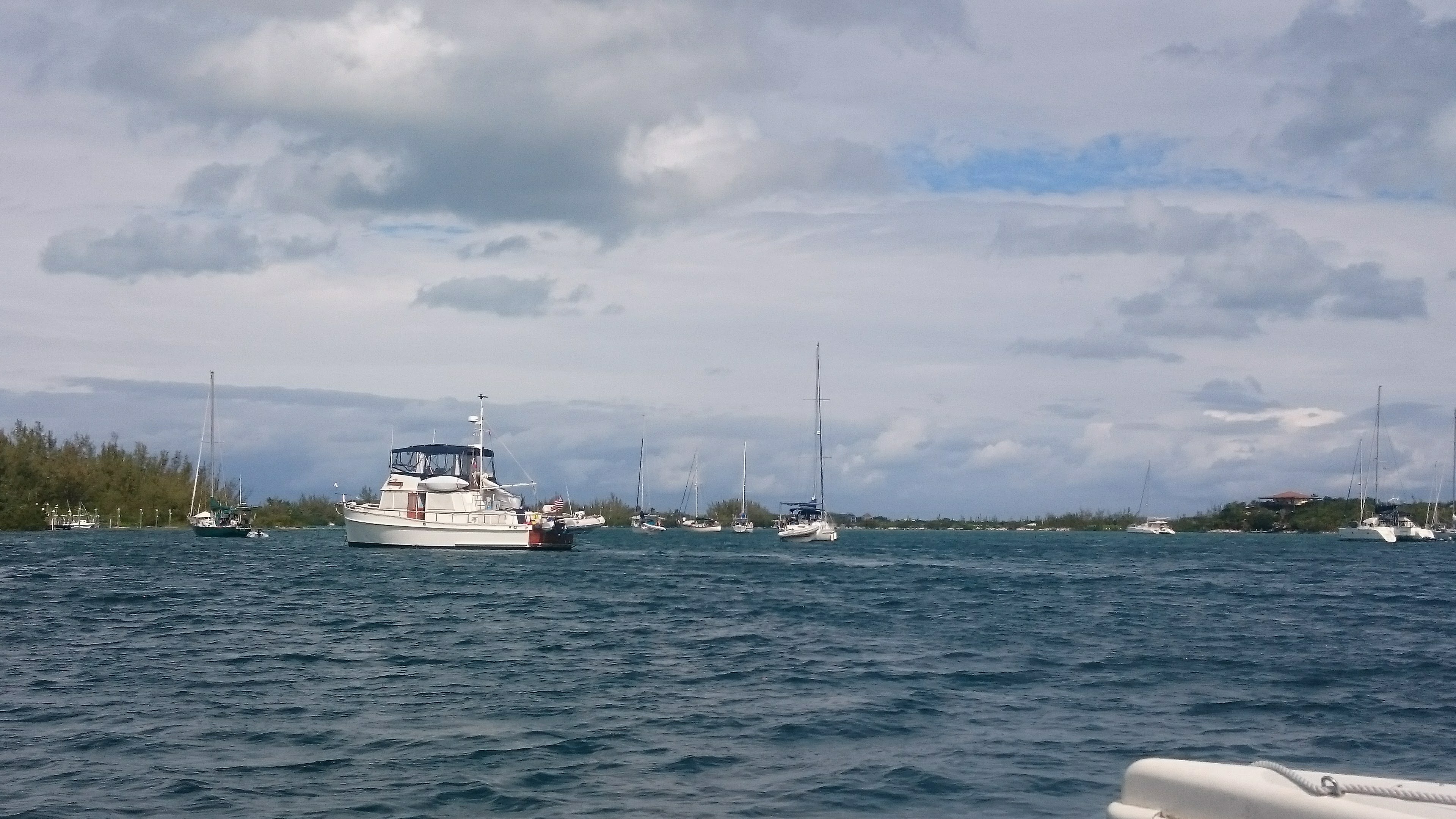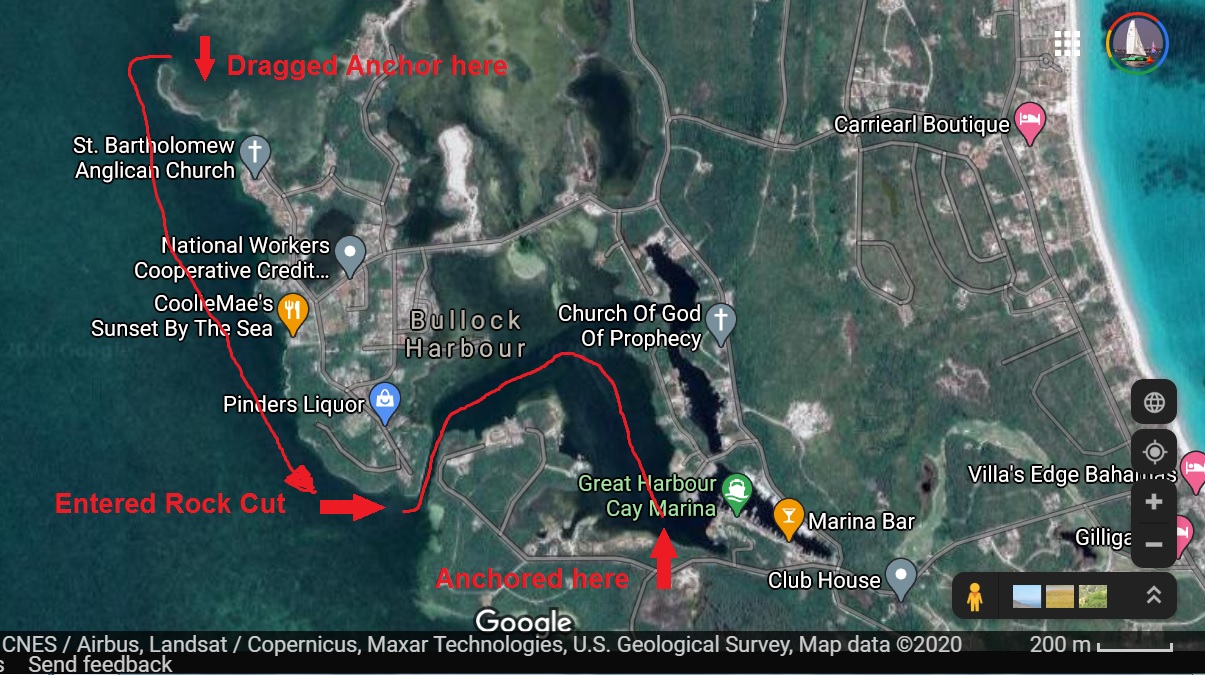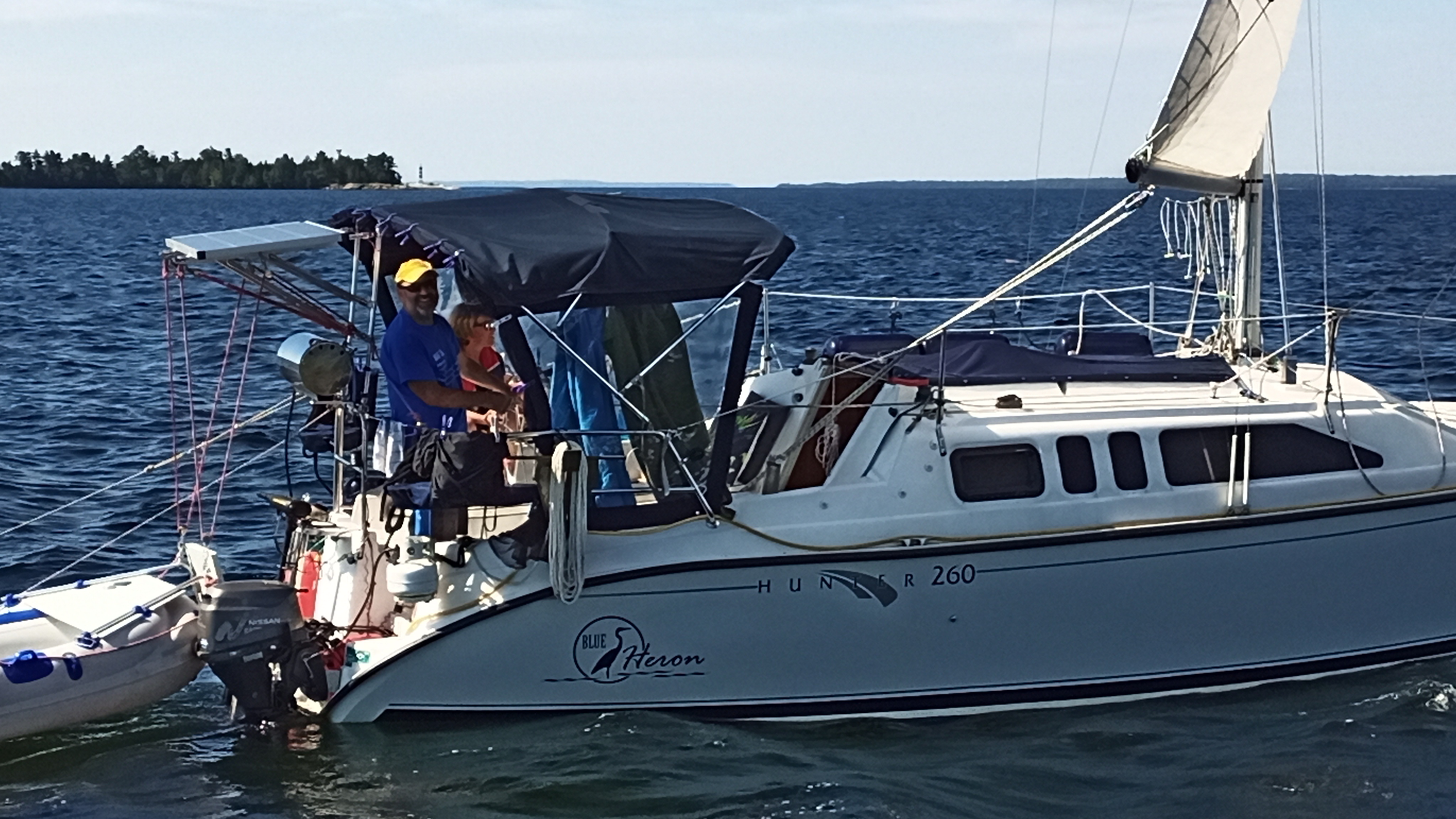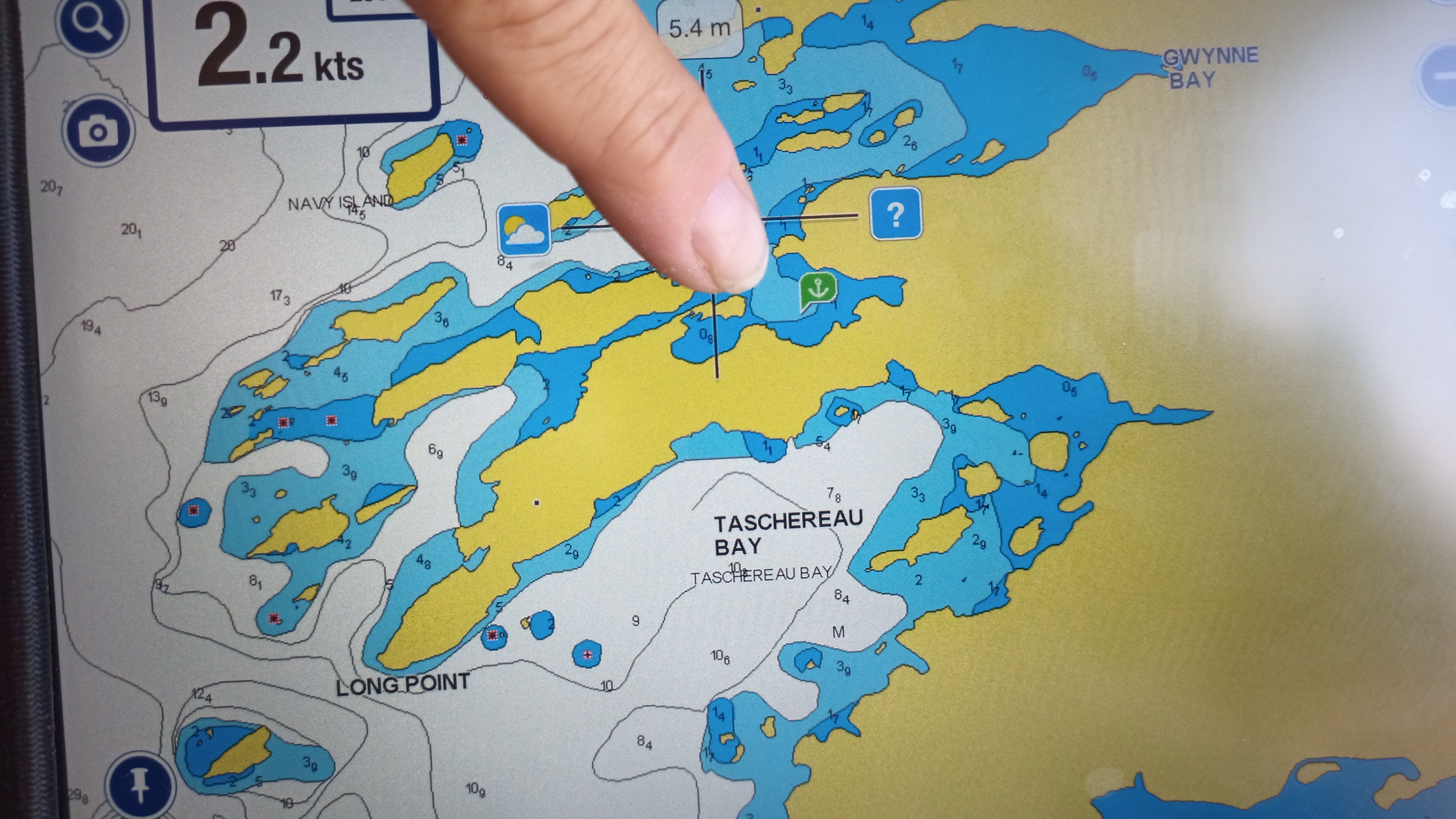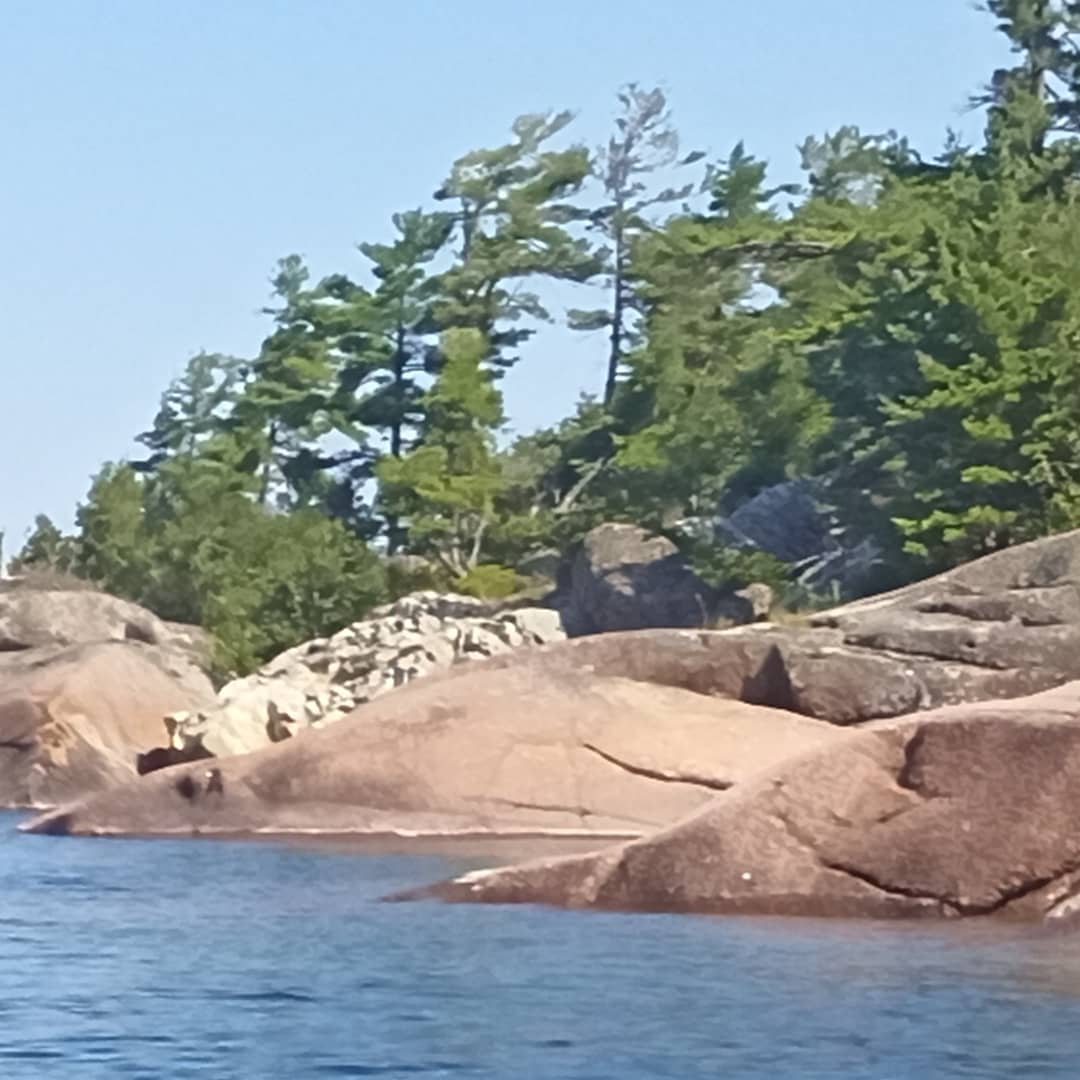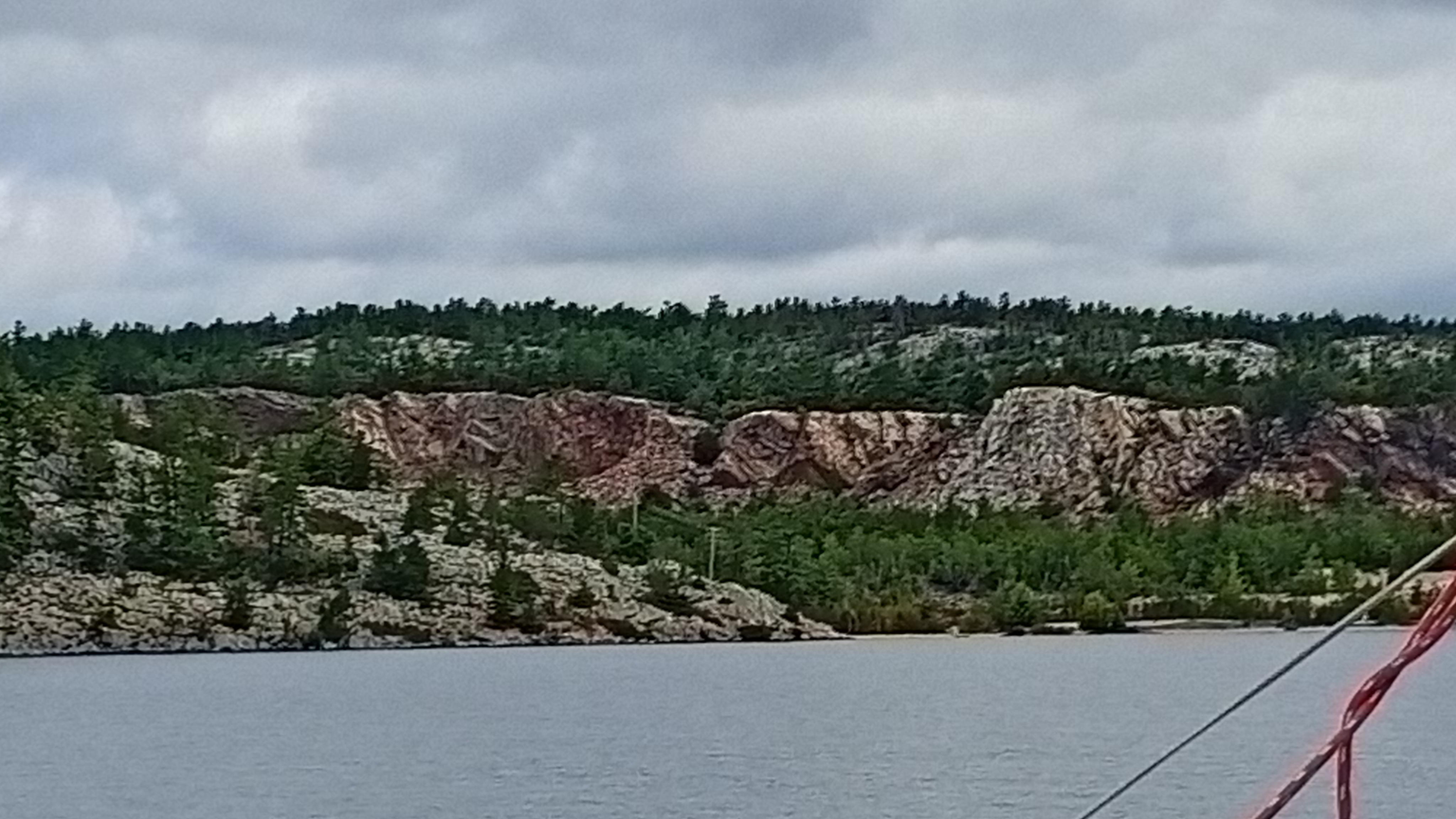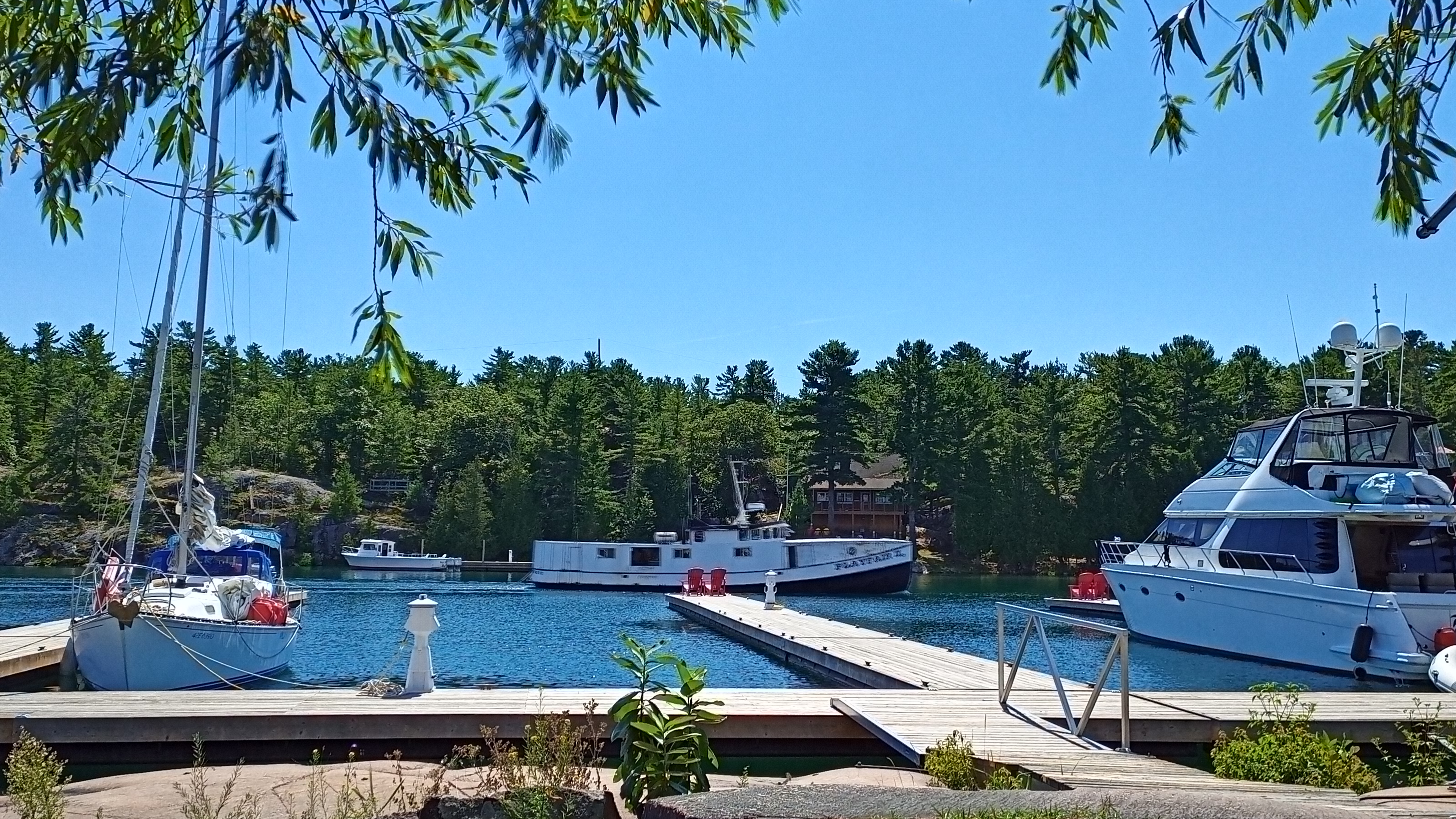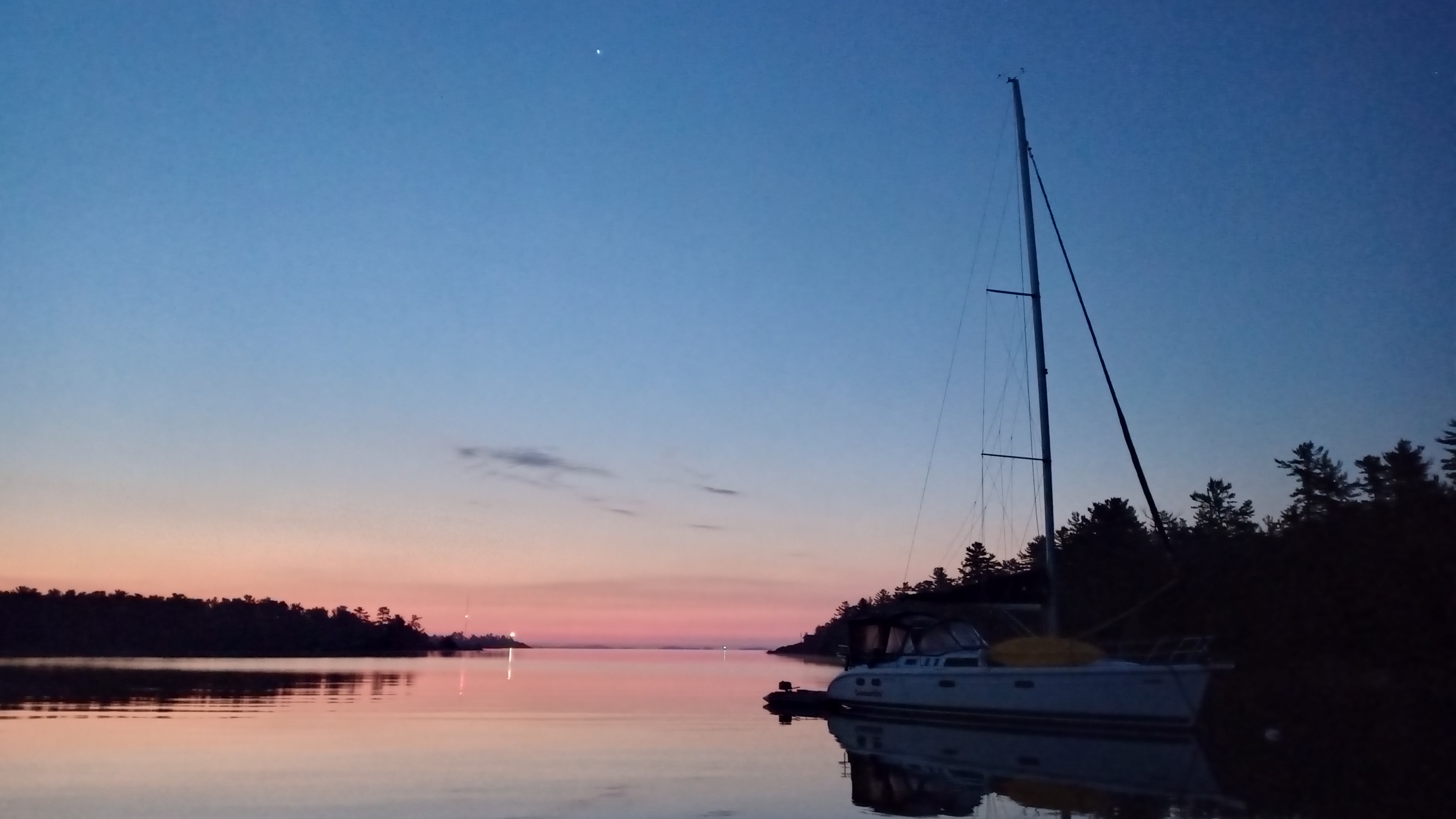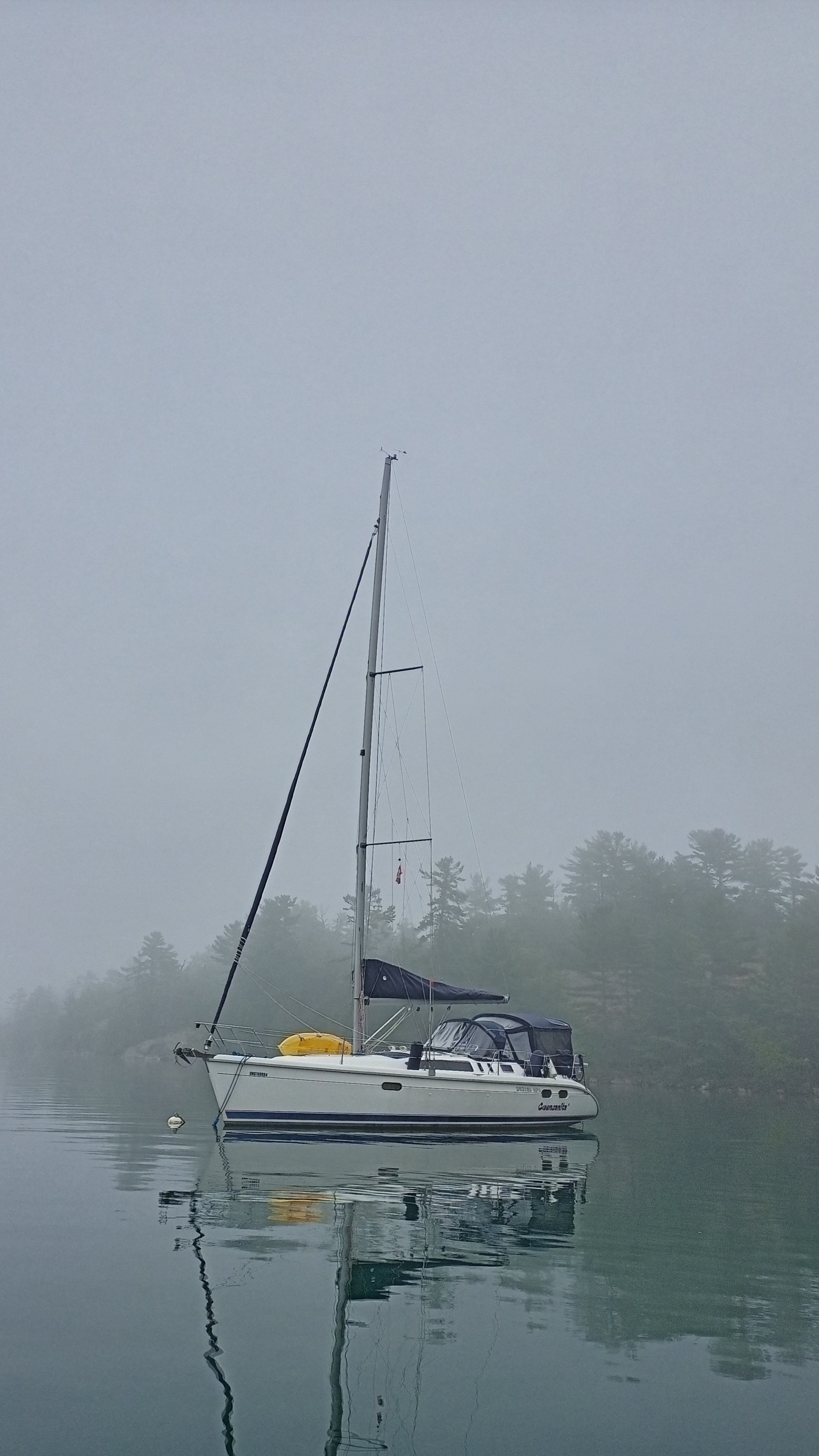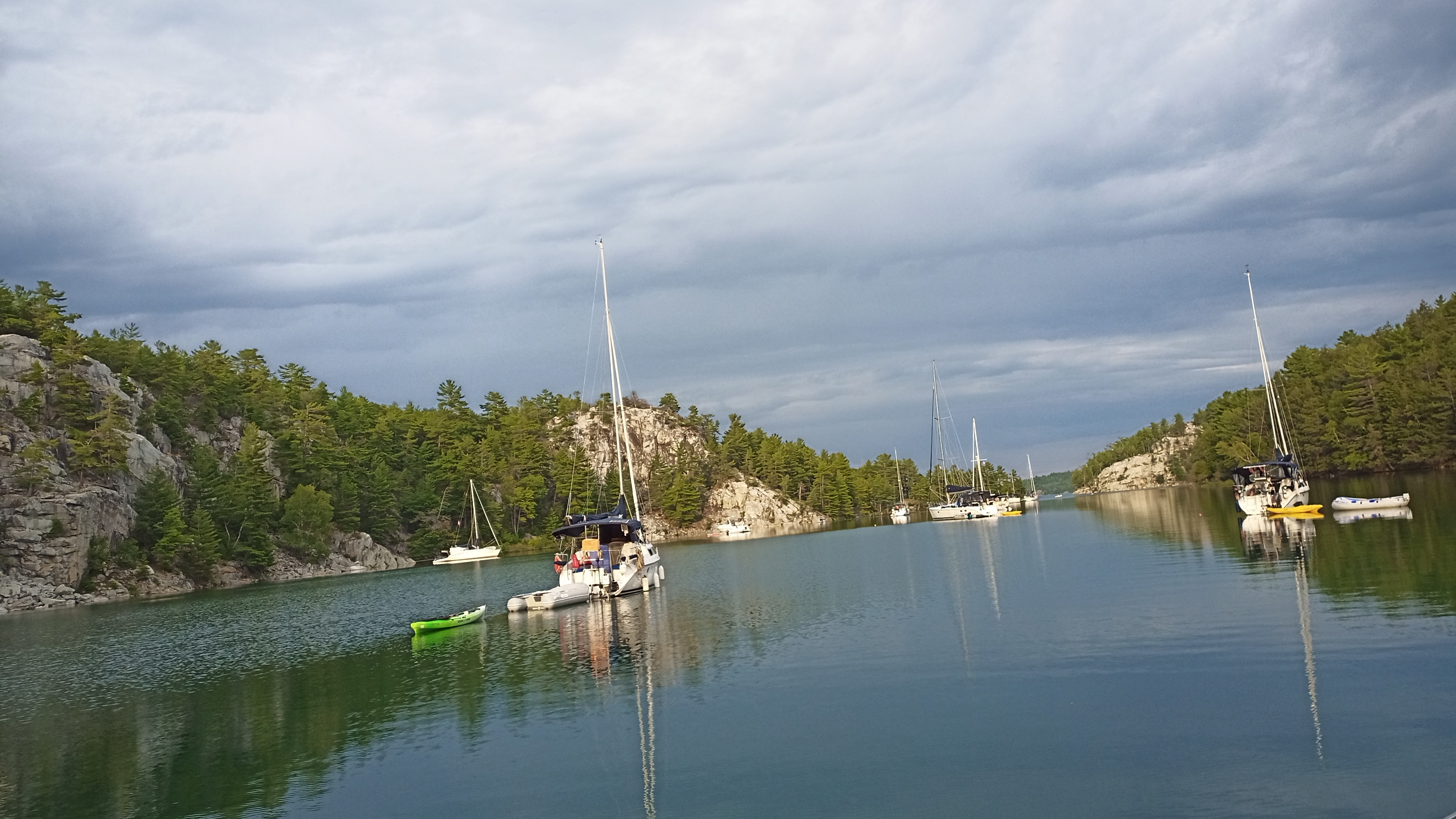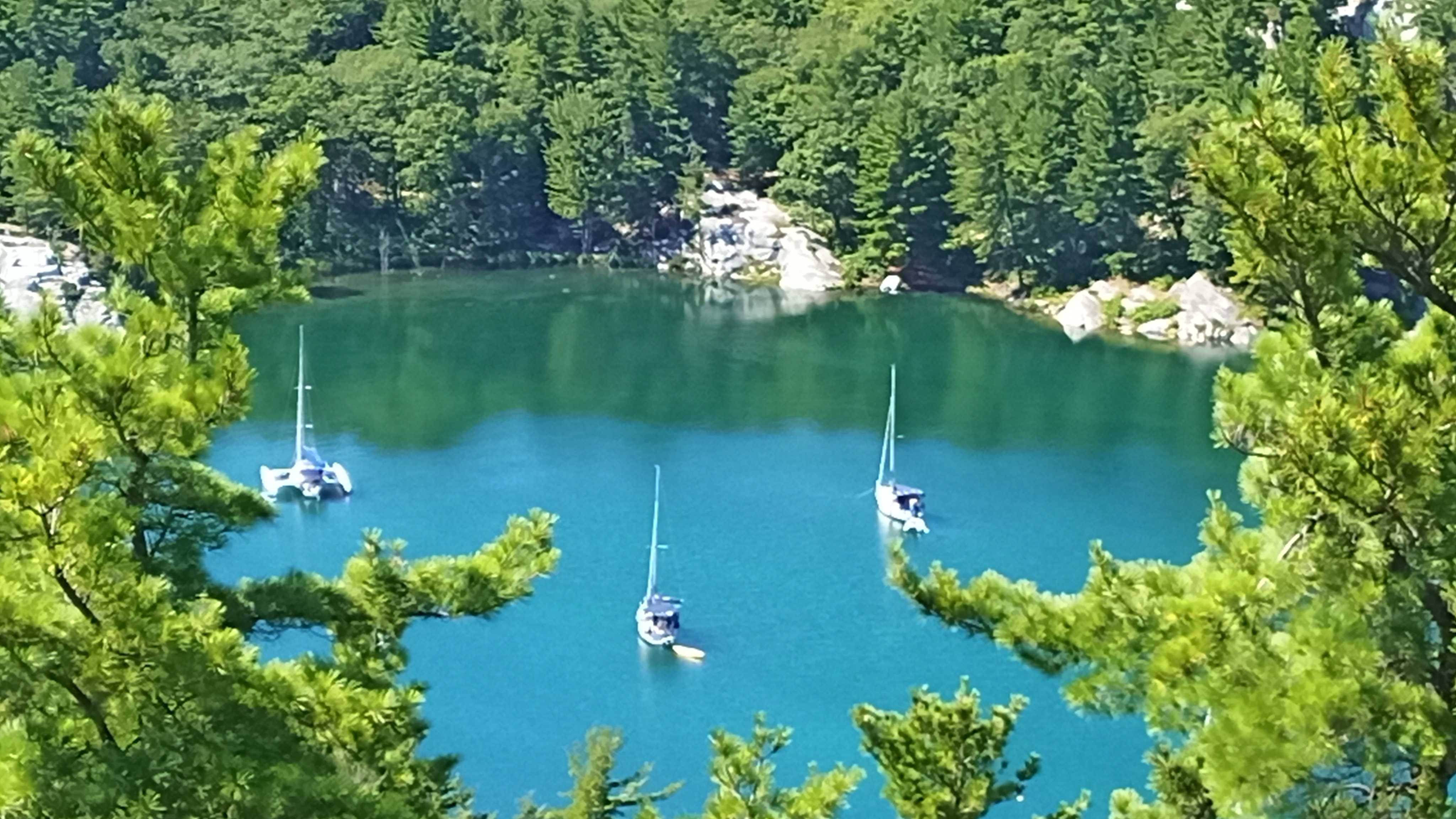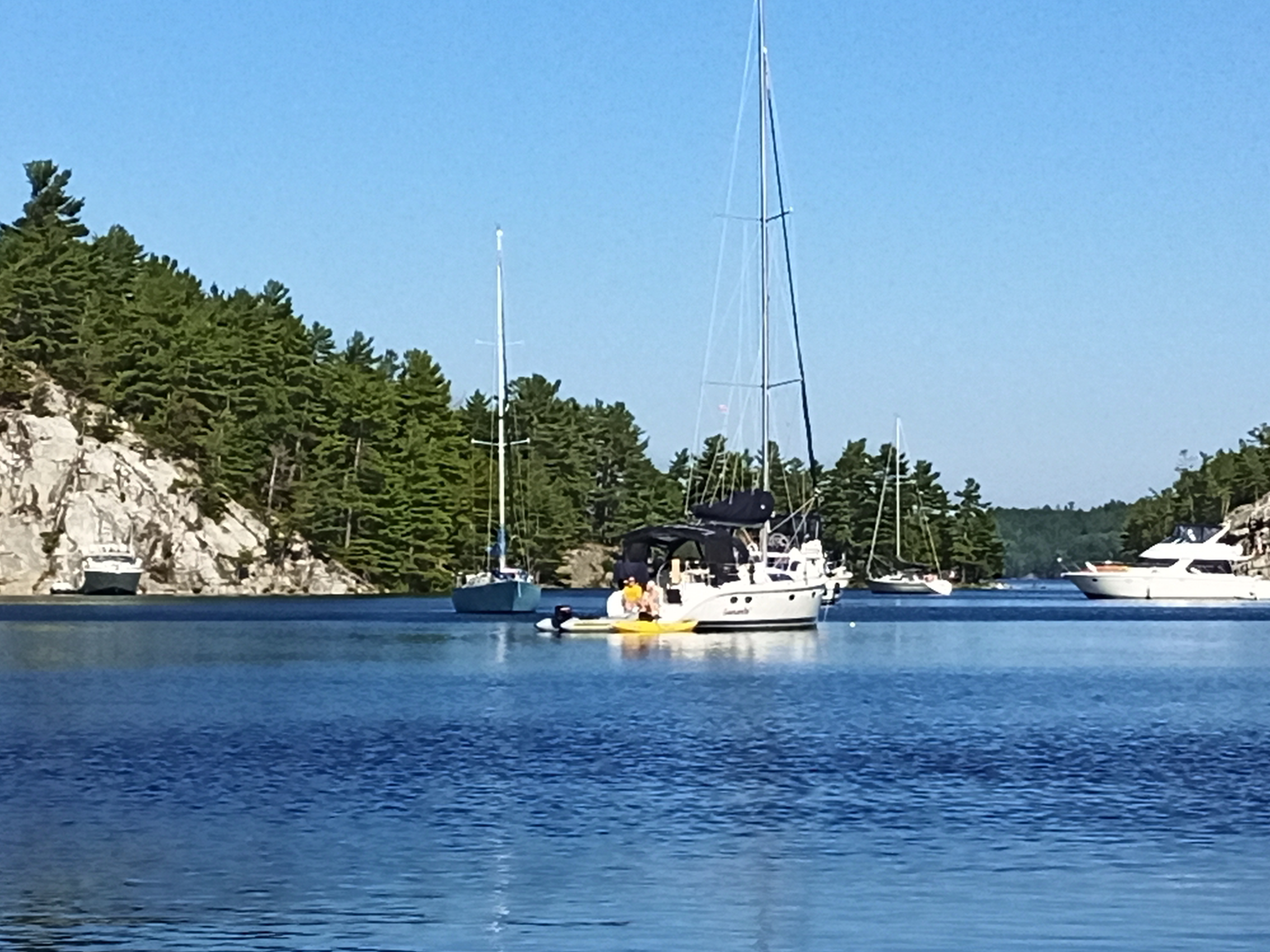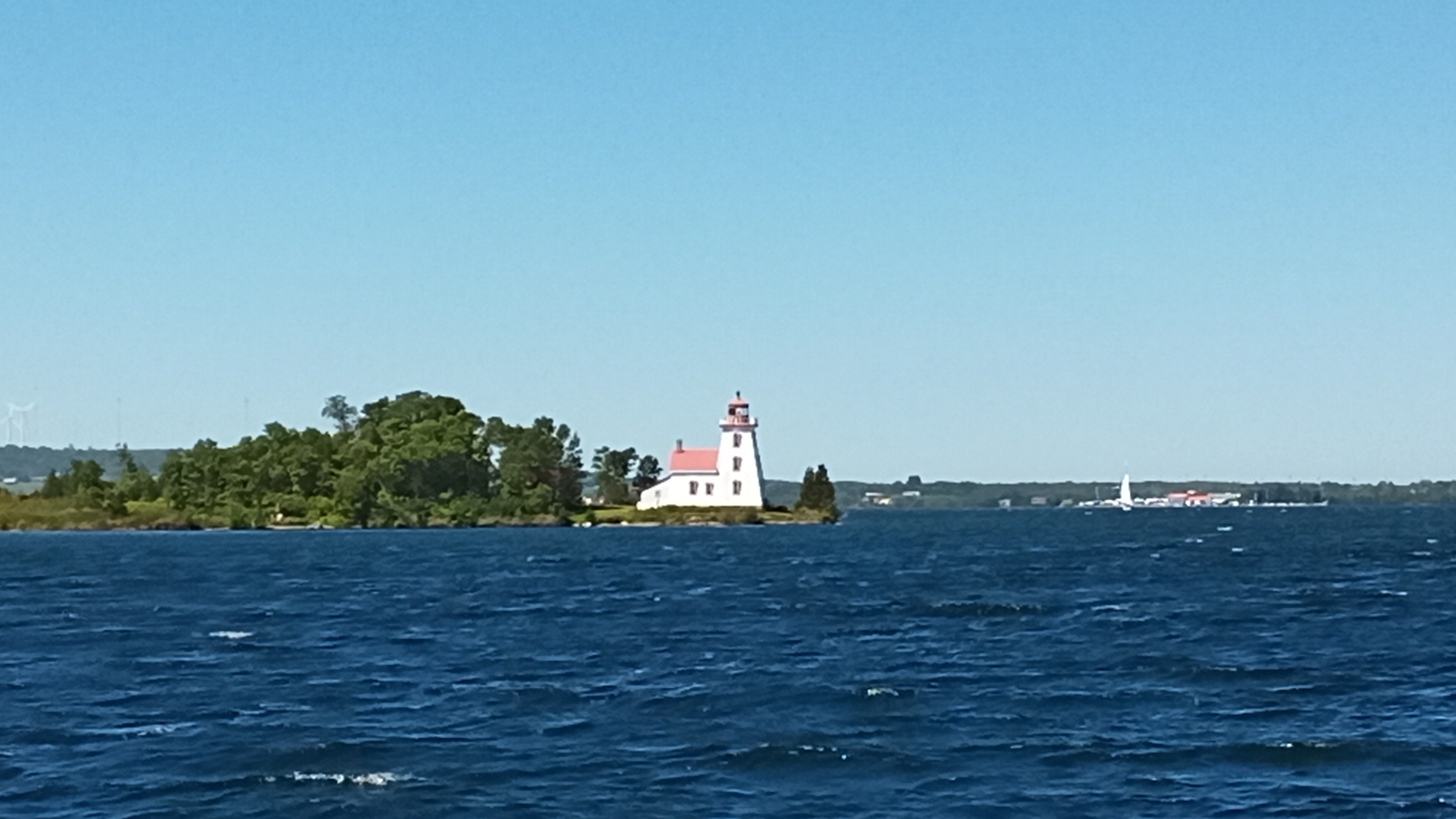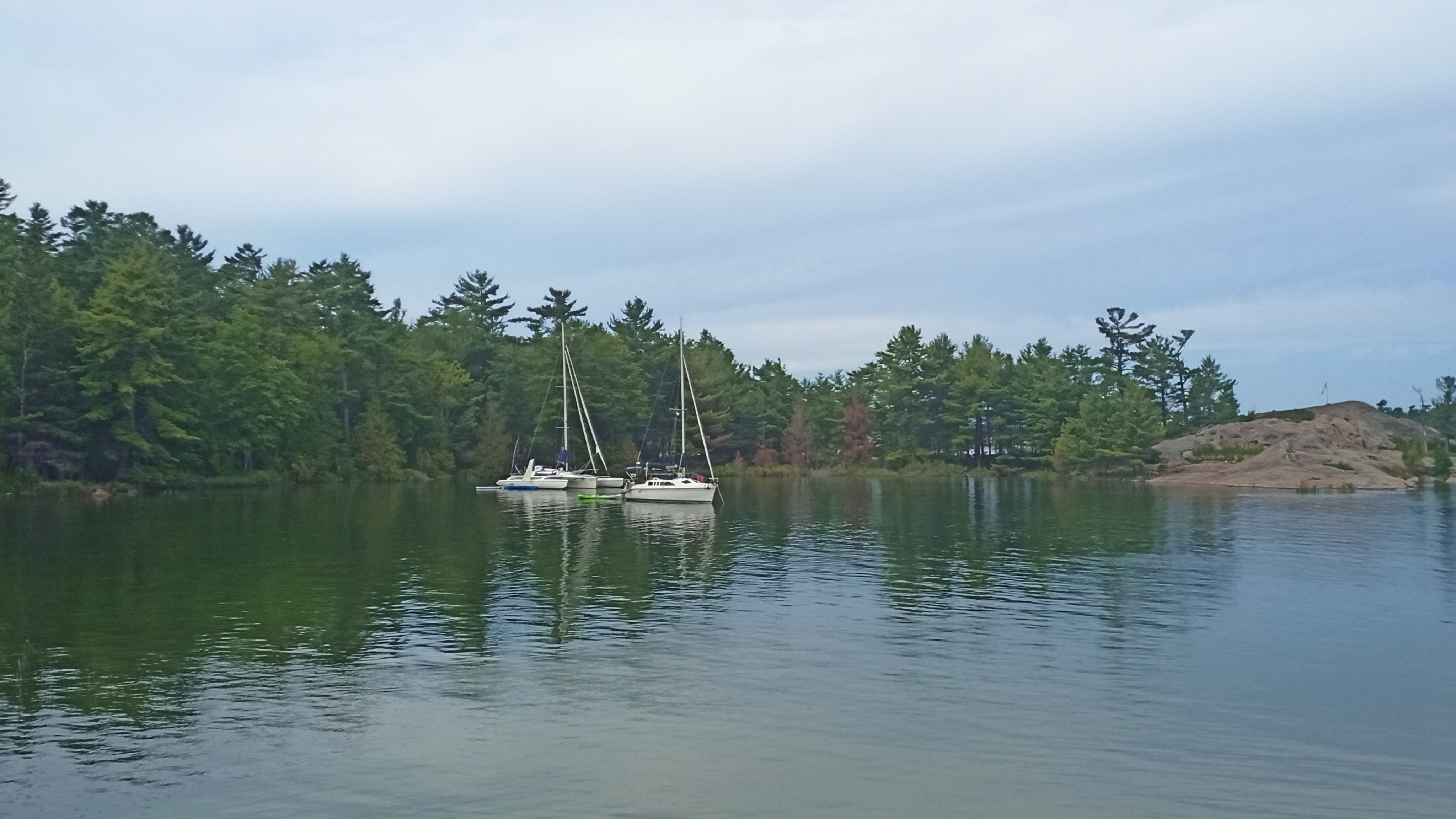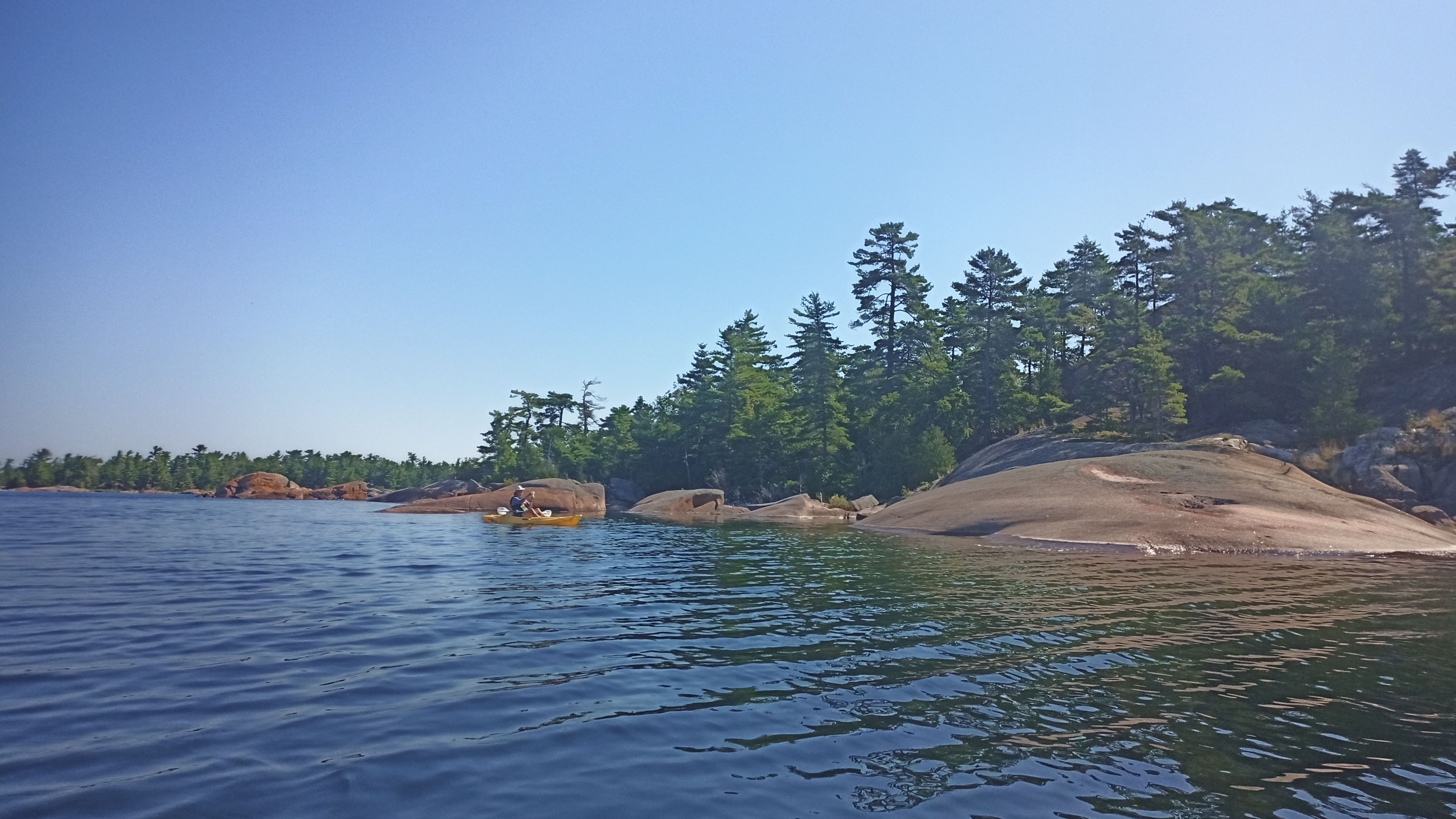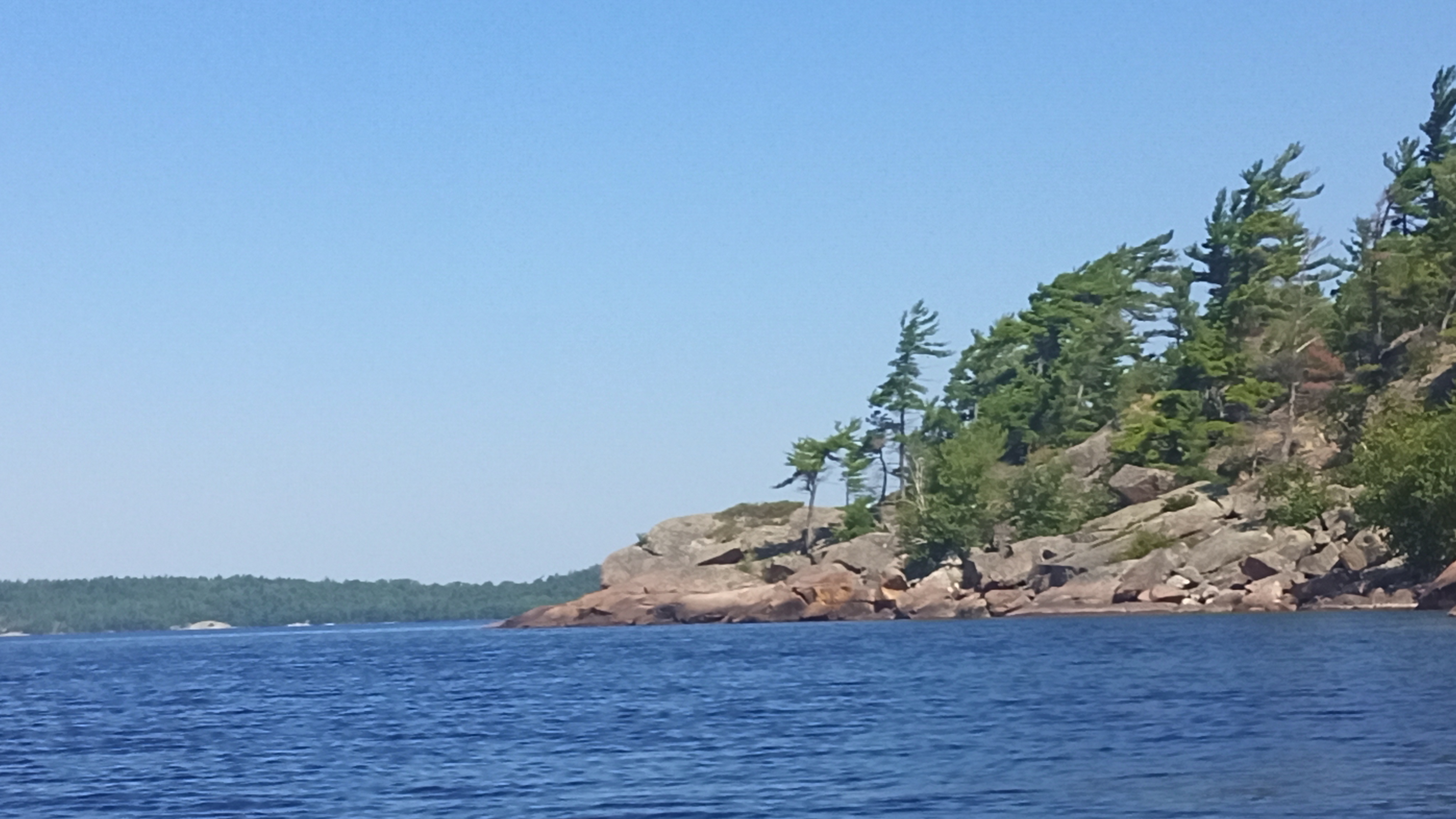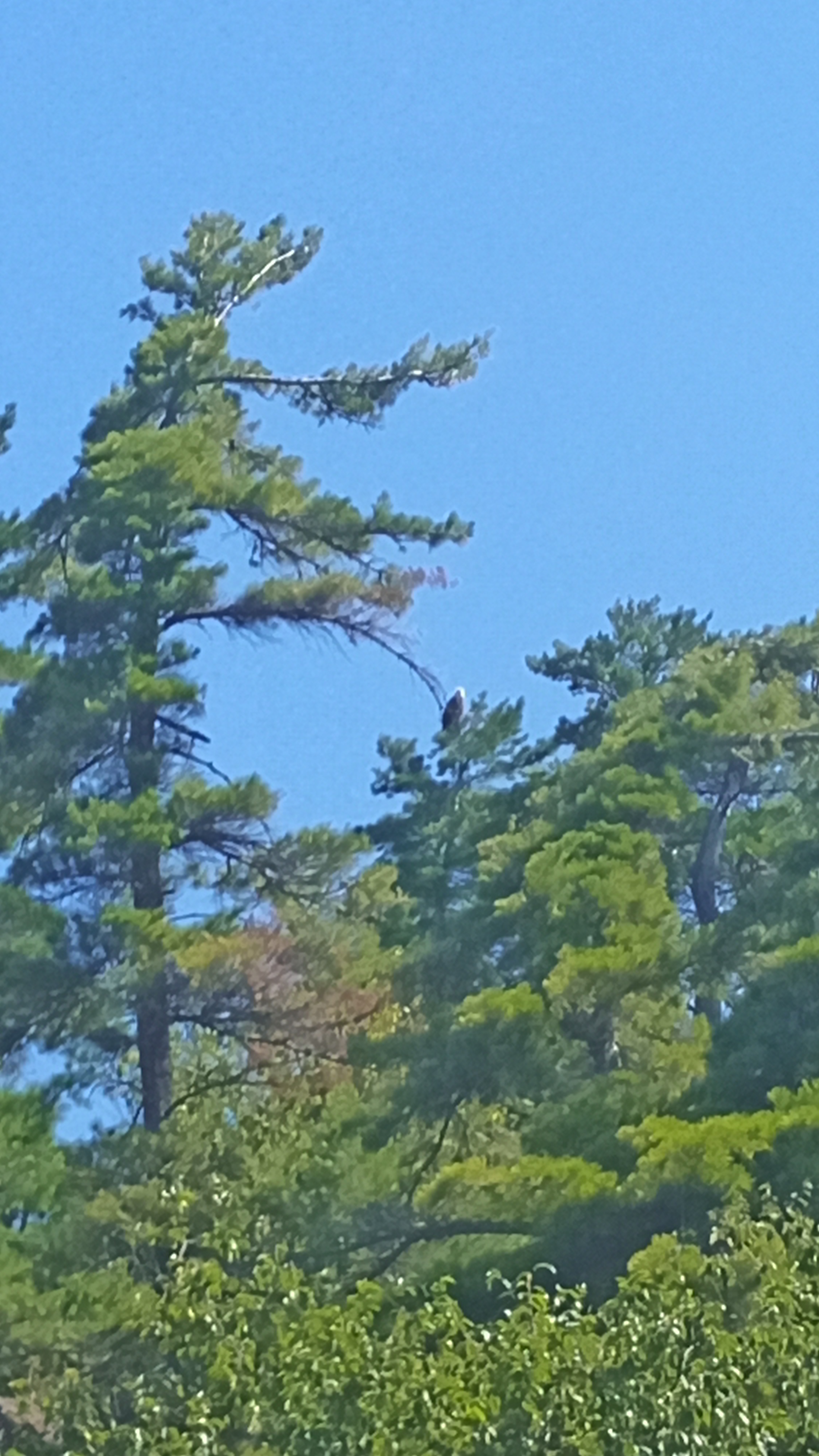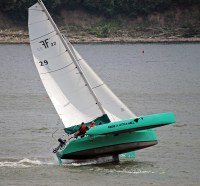In the Fall of 2014, Jim and I decided to trailer our 22′ Trimaran “Raise a Little Hull” down to Florida over Christmas and New Year’s.
We had two weeks of holidays so we figured it would take 2 days to get to the Cape Haze area of Florida’s south-western Gulf Coast and 2 days to get home. So we’d have 9-10 days to cruise with fingers crossed that the winter weather coming and going to Florida would be ok for driving.
At the time, we had a manual transmission E-150 van. I was not super comfortable driving a long load with a stick shift so poor Jim did all of the driving! I was the Navigator and Snacktician.
Thankfully, our 2 day drive down I-75 was smooth sailing and we launched at Eldred’s Marina at Cape Haze on Day 3. We parked the van and trailer there and motored our way north up the Intracoastal Waterway (ICW) to an anchorage we knew about at Englewood Beach. The Gulf shore is lined with low, sandy land covered in mangroves by the shore, scrubby bushes and trees inland and the odd palm tree. Beaches are scattered here and there and are more likely to be exposed along the Gulf shore and not so much along the ICW.
The thing about the ICW on the west or east coasts of Florida is that even though it may be fairly accurately charted, it can change depths without warning if a storm blows in a new sandbar or sinks vessels in the middle of the channel! The prudent sailor will keep a sharp eye on the colour of the water and if he or she spots a light spot ahead, it is best to steer clear of that shallow area…which we didn’t do so we gently rubbed a sandbar just next to an ICW marker!
We enjoyed our first night at anchor yet a quick study of the wind forecast prompted us to sail south toward Cayo Costa State Park just south of Gasparilla Island. We knew of a protected anchorage there to shelter in as some strong west winds were coming. The direction and distance we sailed on this trip would be decided by the weather. We needed to make sure that we had time to see some interesting anchorages yet leave enough time to get home safely. Cruising on a schedule is a bit of a bummer sometimes!
En route to Cayo Costa, we sailed past the village of Boca Grande on Gasparilla Island. We knew this area well as we had rented vacation houses in the area several times in the past. But it was fun to see these places from the water. We knew that dolphins and bull sharks frequented Boca Grande Pass as the fishing must be good but we didn’t see any as we crossed the Pass. Nor did we see any manatee – the gentle, slow-moving “Sea Cows” who munch on seagrass in these subtropical waters. It was a big worry of mine to hit a manatee so I tried to keep a careful eye on the water at all times.
We anchored in a small nook off of Pelican Bay at Cayo Costa State Park. The opening was about 40′ so as our tri is only 18′ wide when unfolded, we had enough width to easily motor through. Once inside, the nook opened into a small shallow pond 350′ across. A perfect hidey hole to escape the coming strong west winds.
We kayaked to the Park dock and explored the trails to the Gulf Side. Visitors can camp on the island so there is a park ferry that brings them there from Bokeelia on nearby Pine Island. Back on the boat, we watched mackerel leaping out of the water, trying to get away from whatever was chasing them in the murky water. Aside from one manatee and a few fishermen who trolled in silently, the place was deserted and quiet.
The next day was Christmas Day and the strong west winds decided our path. Staying out of the wind and high waves of the Gulf of Mexico, we sailed south down the ICW in Pine Island Sound, the protected waters between Pine Island and North and South Captiva Islands. We followed the many, many ICW markers to St. James City at the south end of Pine Island and looked for a local restaurant where we hoped to treat ourselves to a festive supper. But alas, it was closed for the holidays. We learned they wouldn’t open again for a couple of days, so we stayed tied up at their dock and cooked up our own wonderful Christmas meal of Barbeque Turkey breast in a bag, coleslaw and mashed sweet potatoes. Delicious! We took a short walk ashore and made sure that the water dishes for the local cats at the restaurant had some fresh water. A manatee was cruising up and down the canal. What a different way to enjoy Christmas!
The next morning we decided to try to find some fuel. As we neared one of the many canals in St. James City, a fellow hailed us from shore. He had what looked like an F-31 on a trailer on his land. He suggested we could get fuel at a marina up the Monroe Canal so we thanked him and wove our way past charming waterside canal-side homes to the marina.
We had a little time to explore before the marina opened so we took a short walk ashore to a local convenience store for an ice cream and some milk. It was a quiet town with kind of an old Florida coastal feel to it. Everything was kind of weather beaten, and the land was low, sandy and scrubby. It was uncrowded and comfortable.
We moved on and thought we’d find a place to anchor for the night somewhere south of Fort Myers Beach. Not far from Fort Myers a few dolphin came to join us, effortlessly skimming along on our bow waves. Magical. The Fort Myers area is a popular boating area and we motored down the ICW past various crowded mooring fields next to many large fishing boats and lots of vacation homes on the waterway. Suddenly the homes and busy areas disappeared and we were into the Estero State Preserve. We found a secluded area in the mangroves just south of Big Carlo Pass near the New Pass Bridge and dropped anchor. This area is on part of the popular paddling trail Great Calusa Blueway that meanders off of the ICW through the mangroves. Some kayakers passed us with surprised looks as it’s not everyday that a green trimaran anchors there!
We enjoyed kayaking these quiet areas with so many species of birds and other animals to see. There were dolphin fishing nearby as well as Roseate Spoonbills roosting in the trees. Great Blue Herons, Little Green Herons, Night Herons, Egrets, Ibis, and even a Bald Eagle or two were all on display in these quiet areas. Osprey cried above us all day and many of the ICW markers had osprey nests on them. Florida may be known for its beaches and amusement parks, but it is these quiet waterways that make Florida special for us.
The next day the weather was fine and we called for a bridge opening at Big Carlo Pass and headed out into the Gulf of Mexico. We turned south toward Naples. We had hoped to go as far south as the beginning of the Everglades near Marco Island but the weather and our schedule, as always, dictated our course. We could only go as far as Naples. We had a lovely sail to Naples and tucked into Gordon Pass where we motored past massive canal-side homes. We continued to a blessedly quiet area to the south just off of the ICW and again anchored in the mangroves. One thing to remember when anchoring in the mangroves is that the closer you are to the trees, the more the chances of mosquitoes and no-seeums grows! We had screens for our hatch and companionway that are like tulle but finer mesh. This way, the tiny no-seeums couldn’t get in. Those little buggers love Jim and the mosquitoes like me! A bit of breeze helps to keep them down too if you can anchor where the trees aren’t too close around you.
It was time to turn north again so once more we sailed along the Gulf shore. We stopped in at Lovers Key State Park to grab an ice cream and fix one of the nets between our main hull and the ama (pontoon). We beached the boat and pushed an anchor into the sand from the bow and one from the stern to hold her into the oncoming waves. There is a little ice cream shack on the beach and it was great to enjoy a cool treat on a hot day. Back at the boat, some beach walkers wondered if we were in trouble and needed help! Very kind.
We carried on to just west of Fort Myers where we ducked into a canal with an undeveloped mangrove area off to one side. I found this place on Google Maps using the satellite view. Very helpful. I also had a navigation app on my phone which, at the time, was fairly new called Navionics. We still use this app as our primary navigation aide on a tablet and our phones if needed.
So I have never fallen overboard in my life except once on Fanshawe Lake when my brother and I were racing our Y-Flyer (I failed to hook my feet under the hiking strap when a gust came and I hiked out…then fell out!! The next day we motored to what was listed as a “marina” on the app so we could get some ice. As we neared the dock, I waited on the port ama with the docking lines. The dock we were approaching had a line strung about waist height between two poles. I grabbed the line thinking to move the boat forward, when the line gave way and into the drink I went. I kind of flung myself to the end of the dock as I fell so I wouldn’t be between the boat and the dock. I was thankful that the water was deep enough and that I didn’t land on any junk by the dock. It was quite a show for the two dozen folks gathered aboard a big charter fishing boat next door! I just climbed up our boarding ladder and shouted that I needed to cool off anyway!! It turned out the “marina” was a private charter fishing marina. When Jim asked one of the members if we could buy some ice, he said “Have you got a bucket? There’s a shovel in that bin of ice over there. Help yourself to my quota as I don’t need it today!!!” Again, the kindness of strangers.
Provisions properly cooled, we motored away from Fort Myers Beach and out into the Gulf past Sanibel Lighthouse into the clear blue waters off of the Sanibel Island shore. There was no wind but we could see a large pod of dolphin fishing a few hundred metres away. Jim headed toward them and cut the motor. Drifting quietly, we could hear the “whoosh” of their inhaling and exhaling. It was quite a sight as a dozen of these clever mammals encircled schools of fish. Sadly we had to move on. The wind began to fill in and we sailed into Captiva Pass at North Captiva Island and then over to Bokeelia at the north tip of Pine Island. Once again, we found a quiet mangrove pond to drop anchor in.
Now when I scout these places to anchor, I usually have some idea of the depth of the water. There is only a small tide in Florida and as freshwater sailors, it’s pretty easy to forget that little tide. As I lowered the anchor into what we thought was to be at least 1.5 metres deep, the tip of the anchor shaft stuck out of the water!! But we were still floating!? I asked Jim how long the anchor shaft of our 22lb Bruce-style anchor was. He guessed about 18″ so I told him we were in about 16″ of water! We had pulled up the centreboard all the way and tilted up the rudder to enter the mangroves. Jim steered us slowly into the pond with our Tohatsu 6hp outboard. There must have been a little sandbar ahead where the anchor shaft had stuck out but the mangrove pond was too murky to see the bottom. However, we liked the quiet area and decided to stay. Sure enough, the tide soon went out and we settled into the soft muck.
Sometimes in salt water, you can hear a weird “snapping” on the outer hull. When we first heard this we were puzzled. We later learned that microscopic shrimp blow jets of water at the hull to dislodge food thus making the odd crackling noise like Rice Krispies! We heard the tiny creatures again this afternoon and the sound was very loud!
After we settled in and screened up, we went for a paddle to Bokeelia. As we approached the inlet, a long, large dolphin came toward us fishing and passed Jim’s kayak by just a few metres. How special! We enjoyed paddling by this old Florida village. It was pretty quiet. We saw an ice cream cone sign on the local store/marina building so we dragged the kayaks ashore by some old fishing boats. I literally marked “Ice Cream bars and cornets” on my chart for next time! We walked the “town” a little for more exercise but the sun was getting lower and we didn’t want to return to the boat at dark. That would encourage our insect friends to visit and we didn’t want the boat full of bugs!
One of the other interesting things we saw were long shallow draft fishing skiffs with a motor well in the centre of the boat. These were usually steered from a high central steering station above the motor. One fisherman told us that it was easier to see the ever-shifting sandbars and shallows as well as signs of places to fish like birds above the water or jumping mackerel. The nets could go out of the stern of the boat and not get tangled in the prop. Very clever.
On New Year’s Eve we motored and sailed across Charlotte Harbour to Gasparilla Marina in Cape Haze. We thought it might be a happening place for New Year’s Eve. Because of our width, the marina had us tie up to an outside dock so I was worried about a lot of boat wake. But I needn’t have been concerned as the place was pretty quiet. We enjoyed a late lunch and drinks at the marina bar then strolled around the nearby hamlet of Placida. It was a lovely balmy evening.
Back on the boat we enjoyed a barbeque dinner and settled in to enjoy celebratory drinks in the cockpit. Another lone dolphin cruised its way through the marina hunting whatever yummy fish lurk under the docks. In the distance we could hear some fireworks as darkness fell but nothing at all was happening in the marina!! We learned the next day that most folks go out to some nearby island to set off fireworks. Oh well. It was a nice night anyhow.
The next day we wove our way through the narrow channel markers out of the marina with three dolphins riding our bow waves. At Gasparilla Island, we called on the VHF radio for the Boca Grande Causeway swing bridge’s next opening. The bridge tender replied that she could open the bridge in 10 minutes. According to my chart, this particular bridge opens on the hour and every half hour during weekdays. We sadly headed to the boat ramp at Eldred’s Marina nearby and got Raise a Little Hull ready to pack up and drive to Fort Walton Beach on the Florida Panhandle where a friend would store it until March when Jim and his friends Paul and Don would race in the 2015 Corsair Nationals.
We had a wonderful trip with great weather and lots of new places that we explored. There is nothing like cruising new areas on your own boat. Fair winds friends!
A gallery of photos from our cruise is below.
